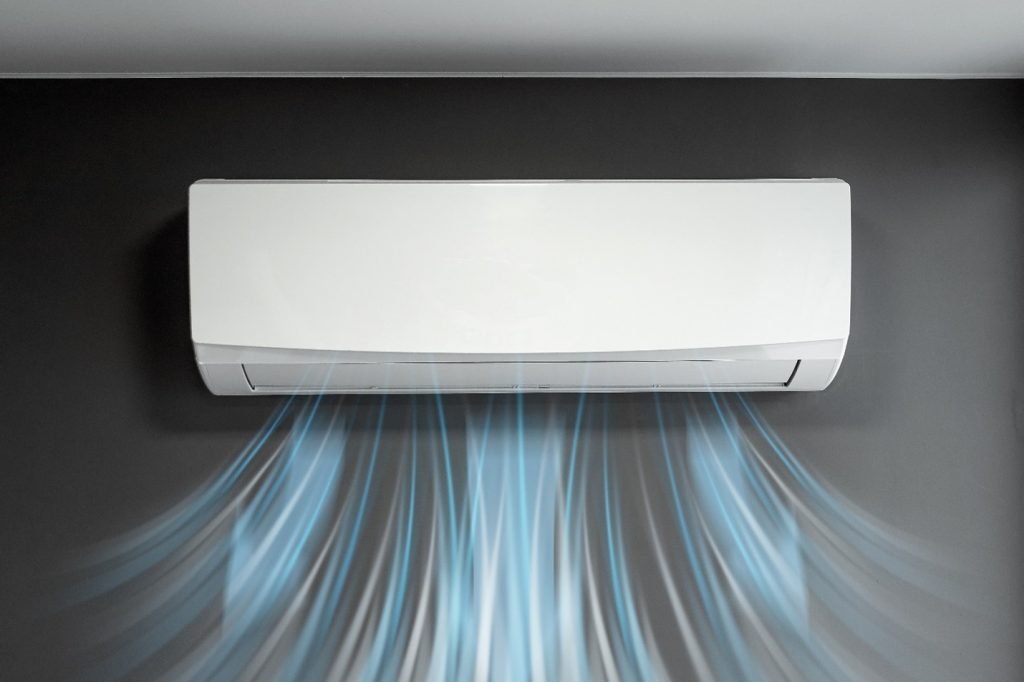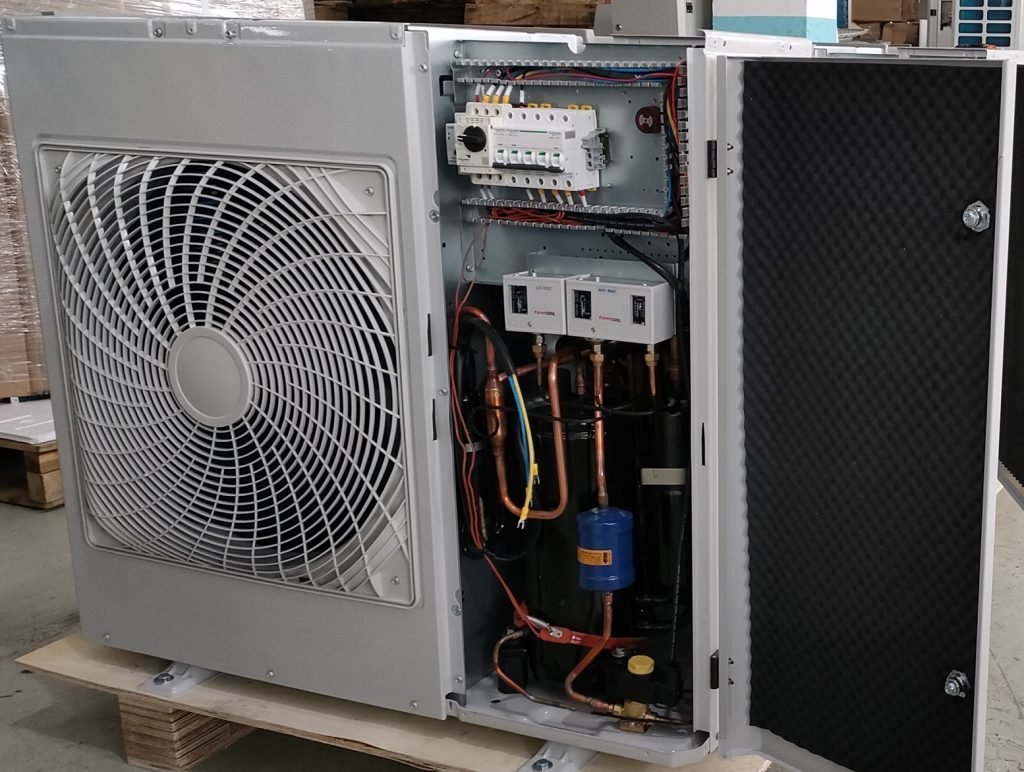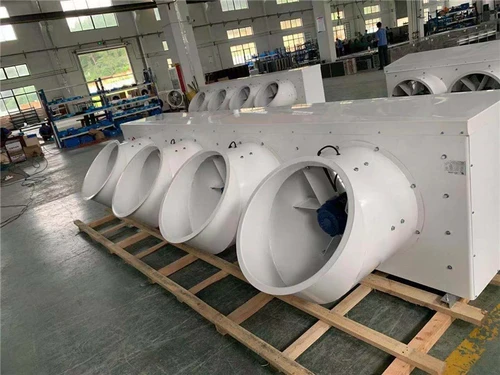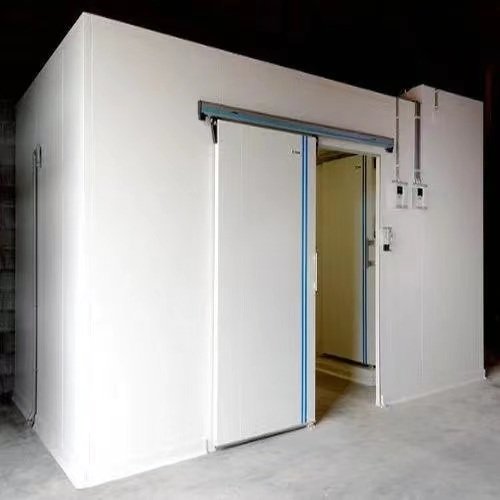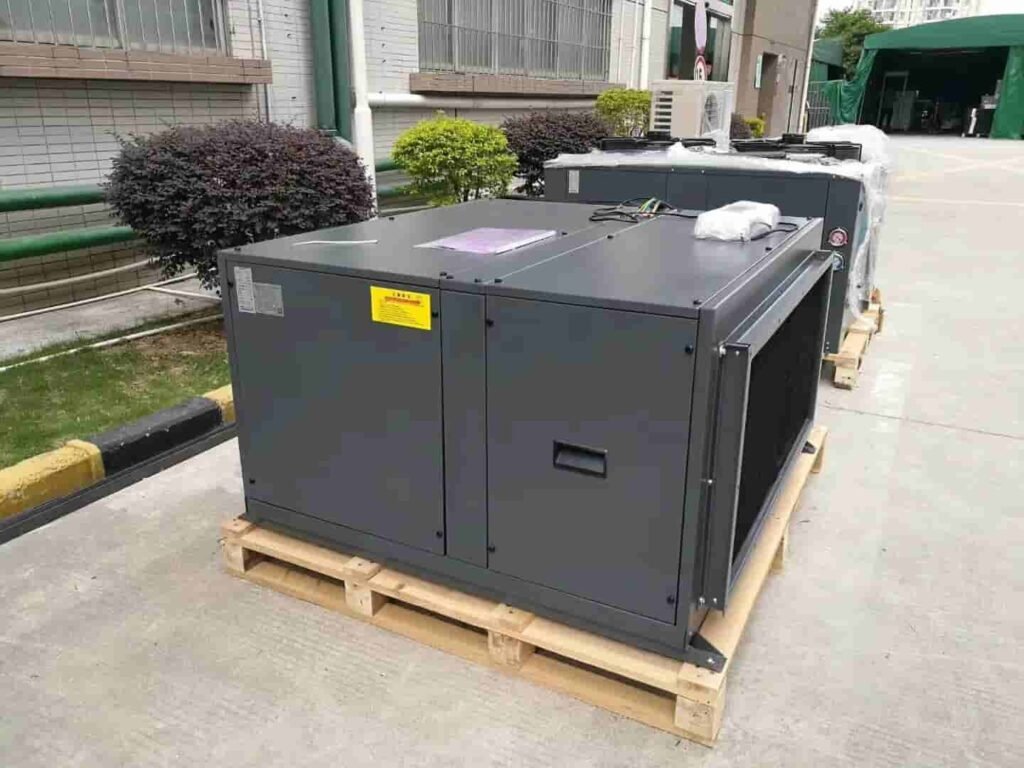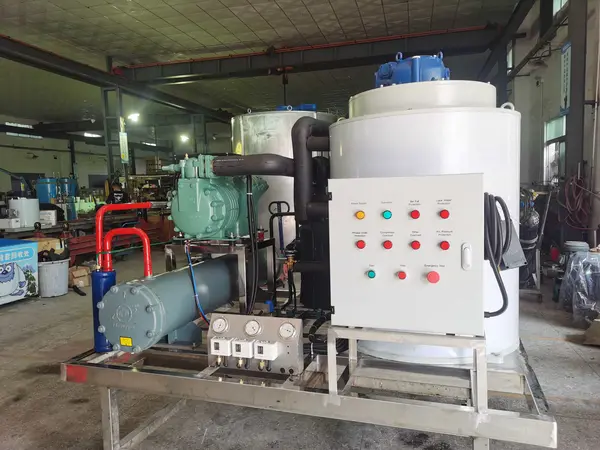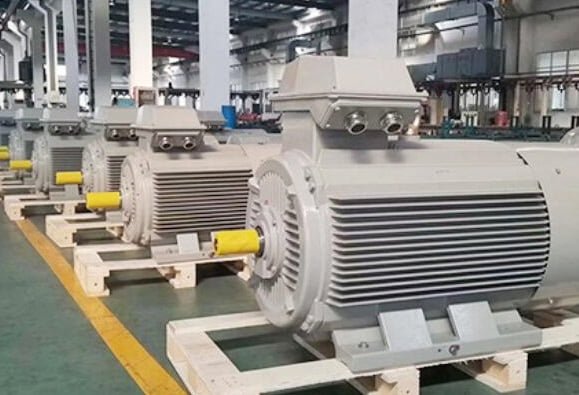ಕೋಲ್ಡ್ ರೂಮ್ ಡೋರ್ ಲಾಕ್ಗಳು ಕೋಲ್ಡ್ ರೂಮ್ ವ್ಯವಸ್ಥೆಗಳ ನಿರ್ಣಾಯಕ ಆದರೆ ಹೆಚ್ಚಾಗಿ ಕಡೆಗಣಿಸಲ್ಪಟ್ಟ ಭಾಗವಾಗಿದೆ. ಅವು ನೇರವಾಗಿ ಸೀಲಿಂಗ್ ಮತ್ತು ಸುರಕ್ಷತೆಯ ಮೇಲೆ ಪರಿಣಾಮ ಬೀರುತ್ತವೆ ತಣ್ಣನೆಯ ಕೋಣೆ, ಶಕ್ತಿಯ ದಕ್ಷತೆ ಮತ್ತು ಒಟ್ಟಾರೆ ಸೇವಾ ಜೀವನದಲ್ಲಿ ಮಹತ್ವದ ಪಾತ್ರ ವಹಿಸುವಾಗ. ಕೋಲ್ಡ್ ಚೈನ್ ಲಾಜಿಸ್ಟಿಕ್ಸ್ನಂತಹ ಕೈಗಾರಿಕೆಗಳಲ್ಲಿ, ಆಹಾರ ಸಂಸ್ಕರಣೆ, ಮತ್ತು ce ಷಧೀಯ ಕೊಠಡಿ, ಕೋಲ್ಡ್ ರೂಮ್ ಡೋರ್ ಲಾಕ್ಗಳ ಕಾರ್ಯಕ್ಷಮತೆಯು ಶೇಖರಣೆಯು ವಿಶ್ವಾಸಾರ್ಹವಾಗಿ ಕಾರ್ಯನಿರ್ವಹಿಸುತ್ತದೆಯೇ ಮತ್ತು ಸಂಗ್ರಹಿಸಿದ ಸರಕುಗಳ ಗುಣಮಟ್ಟವನ್ನು ನಿರ್ವಹಿಸುತ್ತದೆಯೇ ಎಂದು ನಿರ್ಧರಿಸುತ್ತದೆ. ಕೋಲ್ಡ್ ಚೈನ್ ಉದ್ಯಮವು ವಿಕಸನಗೊಳ್ಳುತ್ತಿದ್ದಂತೆ ಮತ್ತು ತಂತ್ರಜ್ಞಾನವು ಪ್ರಗತಿಯಾಗುತ್ತದೆ, ನ ವಿನ್ಯಾಸ ಮತ್ತು ಕ್ರಿಯಾತ್ಮಕತೆ ತಣ್ಣನೆಯ ಕೋಣೆಯ ಬಾಗಿಲು ಲಾಕ್ಗಳು ನಿರಂತರವಾಗಿ ನವೀಕರಿಸುತ್ತವೆ ಮತ್ತು ಅತ್ಯುತ್ತಮವಾಗಿಸುತ್ತವೆ.
ಕೋಲ್ಡ್ ರೂಮ್ ಡೋರ್ ಲಾಕ್ಗಳು ಯಾವುವು?
ಕೋಲ್ಡ್ ರೂಮ್ ಡೋರ್ ಲಾಕ್ಗಳು ಕೋಲ್ಡ್ ರೂಮ್ ಬಾಗಿಲುಗಳಲ್ಲಿ ಸ್ಥಾಪಿಸಲಾದ ವಿಶೇಷ ಲಾಕಿಂಗ್ ಕಾರ್ಯವಿಧಾನಗಳಾಗಿವೆ. ಸಾಮಾನ್ಯ ಬಾಗಿಲು ಬೀಗಗಳಿಗೆ ಹೋಲಿಸಿದರೆ, ಅವರು ಕಡಿಮೆ ತಾಪಮಾನಕ್ಕೆ ಹೆಚ್ಚಿನ ಪ್ರತಿರೋಧವನ್ನು ಪ್ರದರ್ಶಿಸಬೇಕಾಗಿದೆ, ತುಕ್ಕು, ಮತ್ತು ಘನೀಕರಣ, ನ ವಿಶಿಷ್ಟ ಪರಿಸರ ಮತ್ತು ಕಾರ್ಯಾಚರಣೆಯ ಬೇಡಿಕೆಗಳನ್ನು ಪೂರೈಸಲು ಅತ್ಯುತ್ತಮ ಸೀಲಿಂಗ್ ಮತ್ತು ನಿರೋಧನ ಗುಣಲಕ್ಷಣಗಳು ಕೋಲ್ಡ್ ರೂಮ್ ವ್ಯವಸ್ಥೆಗಳು. ತಣ್ಣನೆಯ ಕೋಣೆಯ ಅತ್ಯಗತ್ಯ ಅಂಶವಾಗಿ, ಬಾಗಿಲು ಬೀಗಗಳ ಕಾರ್ಯಕ್ಷಮತೆಯು ಸುರಕ್ಷತೆಯ ಮೇಲೆ ನೇರವಾಗಿ ಪರಿಣಾಮ ಬೀರುತ್ತದೆ, ಇಂಧನ ದಕ್ಷತೆ, ಮತ್ತು ಶೇಖರಣೆಯ ಉಪಯುಕ್ತತೆ. ಕೋಲ್ಡ್ ರೂಮ್ ಪರಿಸರದ ನಿರ್ದಿಷ್ಟ ಸ್ವರೂಪದಿಂದಾಗಿ, ಕೋಲ್ಡ್ ರೂಮ್ ಡೋರ್ ಲಾಕ್ಗಳು ಪ್ರಮಾಣಿತ ಬಾಗಿಲು ಬೀಗಗಳಿಗಿಂತ ಹೆಚ್ಚಿನ ಅವಶ್ಯಕತೆಗಳನ್ನು ಪೂರೈಸಬೇಕು.
1.ಕೋಲ್ಡ್ ರೂಮ್ ಡೋರ್ ಲಾಕ್ಗಳಿಗಾಗಿ ವಿಶೇಷ ವಿನಂತಿ
ಕೋಲ್ಡ್ ರೂಮ್ ಪರಿಸರವನ್ನು ಕಡಿಮೆ ತಾಪಮಾನದಿಂದ ನಿರೂಪಿಸಲಾಗಿದೆ, ಹೆಚ್ಚಿನ ಆರ್ದ್ರತೆ, ಮತ್ತು ಆಗಾಗ್ಗೆ ಬಾಗಿಲು ಬಳಕೆ. ಈ ಪರಿಸ್ಥಿತಿಗಳು ವಸ್ತುಗಳ ಮೇಲೆ ನಿರ್ದಿಷ್ಟ ಅವಶ್ಯಕತೆಗಳನ್ನು ವಿಧಿಸುತ್ತವೆ, ರಚನೆ, ಮತ್ತು ಬಾಗಿಲಿನ ಬೀಗಗಳ ಕಾರ್ಯಕ್ಷಮತೆ.
1.1 ಕಡಿಮೆ-ತಾಪಮಾನದ ಪರಿಸರ
ಕಡಿಮೆ ತಾಪಮಾನಕ್ಕೆ ವಸ್ತು ಪ್ರತಿರೋಧ: ಕೋಲ್ಡ್ ರೂಮ್ ತಾಪಮಾನವು ಸಾಮಾನ್ಯವಾಗಿ 0 ° C ಗಿಂತ ಕಡಿಮೆಯಾಗುತ್ತದೆ, 0 ° C ಗಿಂತ ಕಡಿಮೆ ತಾಪಮಾನವನ್ನು ಸಹ ತಲುಪಿ. ಅಂತಹ ಪರಿಸ್ಥಿತಿಗಳಲ್ಲಿ ಸಾಮಾನ್ಯ ಬಾಗಿಲು ಲಾಕ್ ವಸ್ತುಗಳು ಸುಲಭವಾಗಿ ಆಗಬಹುದು ಮತ್ತು ಬಿರುಕು ಬಿಡುತ್ತವೆ, ಲಾಕ್ ವೈಫಲ್ಯಕ್ಕೆ ಕಾರಣವಾಗುತ್ತದೆ. ತಣ್ಣನೆಯ ಕೋಣೆಯ ಬಾಗಿಲು ಲಾಕ್ಗಳು ಸ್ಟೇನ್ಲೆಸ್ ಸ್ಟೀಲ್ನಂತಹ ಕಡಿಮೆ-ತಾಪಮಾನ-ನಿರೋಧಕ ವಸ್ತುಗಳನ್ನು ಬಳಸಬೇಕು, ಅಲ್ಯೂಮಿನಿಯಂ ಮಿಶ್ರಲೋಹ, ಅಥವಾ ಎಂಜಿನಿಯರಿಂಗ್ ಪ್ಲಾಸ್ಟಿಕ್.
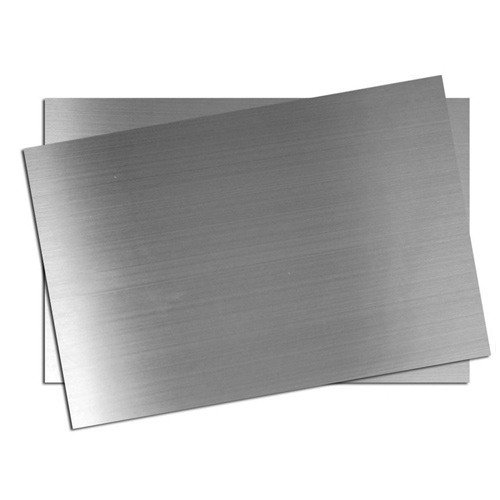
ತುಕ್ಕಹಿಡಿಯದ ಉಕ್ಕು
ಲೂಬ್ರಿಕಂಟ್ ಆಯ್ಕೆ: ಸಾಂಪ್ರದಾಯಿಕ ಲೂಬ್ರಿಕಂಟ್ಗಳು ಕಡಿಮೆ-ತಾಪಮಾನದ ಪರಿಸರದಲ್ಲಿ ಗಟ್ಟಿಯಾಗಬಹುದು, ಬೀಗಗಳನ್ನು ನಿರ್ವಹಿಸಲು ಕಷ್ಟವಾಗುವಂತೆ ಮಾಡುವುದು. ಕೋಲ್ಡ್ ರೂಮ್ ಡೋರ್ ಲಾಕ್ಗಳಿಗೆ ಕಡಿಮೆ-ತಾಪಮಾನದ ಪರಿಸ್ಥಿತಿಗಳಲ್ಲಿ ಸುಗಮ ಕಾರ್ಯಾಚರಣೆಯನ್ನು ಖಚಿತಪಡಿಸಿಕೊಳ್ಳಲು ಕಡಿಮೆ-ತಾಪಮಾನದ ಲೂಬ್ರಿಕಂಟ್ಗಳು ಬೇಕಾಗುತ್ತವೆ.
ವಿರೋಧಿ ಮತ್ತು ವಿರೋಧಿ ಕಂಡೆನ್ಸೇಶನ್ ವಿರೋಧಿ: ತಣ್ಣನೆಯ ಕೋಣೆಯ ಒಳ ಮತ್ತು ಹೊರಗಿನ ನಡುವಿನ ಗಮನಾರ್ಹ ತಾಪಮಾನ ವ್ಯತ್ಯಾಸಗಳು ಘನೀಕರಣಕ್ಕೆ ಕಾರಣವಾಗಬಹುದು, ಲಾಕ್ ಘನೀಕರಿಸುವಿಕೆಗೆ ಕಾರಣವಾಗುತ್ತದೆ. ಘನೀಕರಿಸುವಿಕೆ ಮತ್ತು ಘನೀಕರಣವನ್ನು ತಡೆಗಟ್ಟಲು ತಾಪನ ಅಂಶಗಳು ಅಥವಾ ಸೀಲಿಂಗ್ ಸ್ಟ್ರಿಪ್ಗಳಂತಹ ಕ್ರಮಗಳು ಅವಶ್ಯಕ.
1.2 ಹೆಚ್ಚಿನ ಆರ್ದ್ರತೆ ಪರಿಸರ
ತುಕ್ಕು ಮತ್ತು ತುಕ್ಕು ಪ್ರತಿರೋಧ: ನಲ್ಲಿ ಹೆಚ್ಚಿನ ಆರ್ದ್ರತೆ ತಣ್ಣನೆಯ ಕೋಣೆ ಪರಿಸರಗಳು ಸ್ಟ್ಯಾಂಡರ್ಡ್ ಮೆಟಲ್ ಲಾಕ್ಗಳನ್ನು ತುಕ್ಕು ಮತ್ತು ನಾಶಕ್ಕೆ ಕಾರಣವಾಗಬಹುದು. ಕೋಲ್ಡ್ ರೂಮ್ ಡೋರ್ ಲಾಕ್ಗಳಿಗೆ ಆಂಟಿ-ಸೋರೇಷನ್ ಚಿಕಿತ್ಸೆಗಳು ಬೇಕಾಗುತ್ತವೆ, ಉದಾಹರಣೆಗೆ ಕಲಾಯಿ ಅಥವಾ ಪುಡಿ ಲೇಪನ, ಅವರ ಸೇವಾ ಜೀವನವನ್ನು ವಿಸ್ತರಿಸಲು.
ಸೀಲಿಂಗ್ ಕಾರ್ಯಕ್ಷಮತೆ: ಪರಿಣಾಮಕಾರಿ ಸೀಲಿಂಗ್ ತಂಪಾದ ಗಾಳಿಯ ಸೋರಿಕೆ ಮತ್ತು ಬೆಚ್ಚಗಿನ ಗಾಳಿಯ ಒಳನುಗ್ಗುವಿಕೆಯನ್ನು ತಡೆಯುತ್ತದೆ, ಸ್ಥಿರವಾದ ಆಂತರಿಕ ವಾತಾವರಣವನ್ನು ಕಾಪಾಡಿಕೊಳ್ಳಿ ಮತ್ತು ಶಕ್ತಿಯ ಬಳಕೆಯನ್ನು ಕಡಿಮೆ ಮಾಡಿ.
1.3 ಆಗಾಗ್ಗೆ ಬಾಗಿಲು ಬಳಕೆ
ಬಾಳಿಕೆ: ಕೋಲ್ಡ್ ರೂಮ್ ಡೋರ್ಸ್ ಆಗಾಗ್ಗೆ ತೆರೆಯಿರಿ ಮತ್ತು ಮುಚ್ಚಿ, ಭಾರೀ ಬಳಕೆಯನ್ನು ತಡೆದುಕೊಳ್ಳಲು ಬಾಗಿಲು ಬೀಗಗಳು ಬೇಕಾಗುತ್ತವೆ. ಬಾಳಿಕೆ ಖಚಿತಪಡಿಸಿಕೊಳ್ಳಲು ಹೆಚ್ಚಿನ ಸಾಮರ್ಥ್ಯದ ವಸ್ತುಗಳು ಮತ್ತು ಕಠಿಣ ಗುಣಮಟ್ಟದ ಪರೀಕ್ಷೆ ಅಗತ್ಯ.
ಸ್ಥಿರತೆ: ಆಗಾಗ್ಗೆ ಬಳಕೆಯ ಹೊರತಾಗಿಯೂ ಬೀಗಗಳು ಸ್ಥಿರವಾದ ಕಾರ್ಯಕ್ಷಮತೆಯನ್ನು ಕಾಪಾಡಿಕೊಳ್ಳಬೇಕು, ಕಾರ್ಯಾಚರಣೆಯ ವೈಫಲ್ಯಗಳನ್ನು ತಪ್ಪಿಸುವುದು.
ಕಾರ್ಯಾಚರಣೆಯ ಸುಲಭ: ಕೋಲ್ಡ್ ರೂಮಿನಲ್ಲಿರುವ ಕಾರ್ಮಿಕರು ಹೆಚ್ಚಾಗಿ ಬೃಹತ್ ಬಟ್ಟೆ ಮತ್ತು ಕೈಗವಸುಗಳನ್ನು ಧರಿಸುತ್ತಾರೆ, ಆದ್ದರಿಂದ ಪ್ರವೇಶ ಮತ್ತು ನಿರ್ಗಮನವನ್ನು ಸುಲಭಗೊಳಿಸಲು ಬಾಗಿಲು ಬೀಗಗಳು ಕಾರ್ಯನಿರ್ವಹಿಸಲು ಸುಲಭವಾಗಬೇಕು.
2.ತಣ್ಣನೆಯ ಕೋಣೆಯ ಬಾಗಿಲಿನ ಬೀಗಗಳ ಪ್ರಾಥಮಿಕ ಕಾರ್ಯಗಳು
2.1 ಸೀಲಿಂಗ್ ಅನ್ನು ಖಚಿತಪಡಿಸಿಕೊಳ್ಳಿ
ನ ಪ್ರಮುಖ ಕಾರ್ಯಗಳಲ್ಲಿ ಒಂದಾಗಿದೆ ತಣ್ಣನೆಯ ಕೋಣೆ ಪರಿಣಾಮಕಾರಿ ಮುದ್ರೆಯನ್ನು ನಿರ್ವಹಿಸುವುದು ಬಾಗಿಲಿನ ಬೀಗಗಳು.
- ಲಾಕ್ ಫ್ರೇಮ್ ವಿರುದ್ಧ ಬಾಗಿಲನ್ನು ಸಂಕುಚಿತಗೊಳಿಸುತ್ತದೆ, ಸೀಲ್ ಸ್ಟ್ರಿಪ್ಸ್ ಫ್ರೇಮ್ಗೆ ಬಿಗಿಯಾಗಿ ಅಂಟಿಕೊಳ್ಳುವುದನ್ನು ಖಚಿತಪಡಿಸಿಕೊಳ್ಳಿ, ಗಾಳಿಯಾಡದತೆಯನ್ನು ಸಾಧಿಸುವುದು.
- ಹೆಚ್ಚಿನ ದಕ್ಷತೆಯ ಸೀಲಿಂಗ್ ತಂಪಾದ ಗಾಳಿಯ ನಷ್ಟವನ್ನು ಕಡಿಮೆ ಮಾಡುತ್ತದೆ ಮತ್ತು ಬೆಚ್ಚಗಿನ ಗಾಳಿಯ ಒಳನುಗ್ಗುವಿಕೆಯನ್ನು ತಡೆಯುತ್ತದೆ, ಆಂತರಿಕ ತಾಪಮಾನ ಸ್ಥಿರತೆಯನ್ನು ಕಾಪಾಡಿಕೊಳ್ಳಿ.
- ಸಾಕಷ್ಟು ಸೀಲಿಂಗ್ ಹೆಚ್ಚಿದ ಶಕ್ತಿಯ ಬಳಕೆಗೆ ಕಾರಣವಾಗಬಹುದು ಮತ್ತು ಸಂಗ್ರಹಿಸಿದ ಸರಕುಗಳ ಗುಣಮಟ್ಟವನ್ನು ರಾಜಿ ಮಾಡಬಹುದು.
2.2 ಭದ್ರತೆಯನ್ನು ಒದಗಿಸಿ
ತಣ್ಣನೆಯ ಕೋಣೆಯ ಬಾಗಿಲು ಭದ್ರತೆಯಲ್ಲಿ ಬೀಗಗಳು ಸಹ ಪ್ರಮುಖ ಪಾತ್ರವಹಿಸುತ್ತವೆ:
- ಐಟಂ ರಕ್ಷಣೆ: ಅನಧಿಕೃತ ಪ್ರವೇಶವನ್ನು ತಡೆಯುತ್ತದೆ, ವಿಶೇಷವಾಗಿ ಹೆಚ್ಚಿನ ಮೌಲ್ಯದ ಸರಕುಗಳನ್ನು ಹೊಂದಿರುವ ಸಂಗ್ರಹಣೆಗಳಲ್ಲಿ.
- ಸಿಬ್ಬಂದಿ ಸುರಕ್ಷತೆ: ಕೆಲವು ಬೀಗಗಳು ವ್ಯಕ್ತಿಗಳು ತಣ್ಣನೆಯ ಕೋಣೆಯೊಳಗೆ ಸಿಕ್ಕಿಹಾಕಿಕೊಳ್ಳದಂತೆ ತಡೆಯಲು ಆಂತರಿಕ ಬಿಡುಗಡೆ ಕಾರ್ಯವಿಧಾನವನ್ನು ಹೊಂದಿವೆ.
- ಅಲಾರಾಂ ವೈಶಿಷ್ಟ್ಯಗಳು: ಆಧುನಿಕ ಬೀಗಗಳು ಬುದ್ಧಿವಂತ ಮಾನಿಟರ್ ವೈಶಿಷ್ಟ್ಯಗಳನ್ನು ಒಳಗೊಂಡಿರಬಹುದು, ಅನಧಿಕೃತ ಪ್ರವೇಶವನ್ನು ಪ್ರಯತ್ನಿಸಿದಾಗ ಅಲಾರಂಗಳನ್ನು ಪ್ರಚೋದಿಸುವಂತಹ, ಒಟ್ಟಾರೆ ಸುರಕ್ಷತೆಯನ್ನು ಹೆಚ್ಚಿಸುತ್ತದೆ.
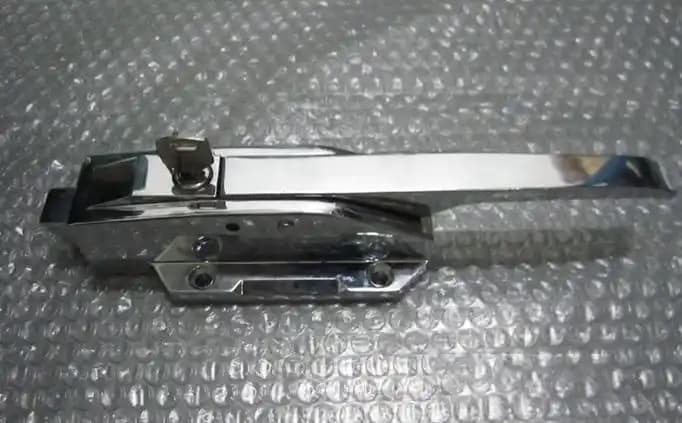
2.3 ಕಡಿಮೆ ತಾಪಮಾನದಲ್ಲಿ ಫ್ರೀಜ್ ಅಥವಾ ವೈಫಲ್ಯವನ್ನು ತಡೆಯಿರಿ
ತಣ್ಣನೆಯ ಕೋಣೆ ಲಾಕ್ ಘನೀಕರಿಸುವಿಕೆ ಅಥವಾ ಅಸಮರ್ಪಕ ಕಾರ್ಯವನ್ನು ತಡೆಗಟ್ಟಲು ಪರಿಸರಗಳು ಉತ್ತಮ ಕಾರ್ಯಕ್ಷಮತೆಯನ್ನು ಬಯಸುತ್ತವೆ:
- ತೀವ್ರ ಶೀತದಲ್ಲಿ ಸುಗಮ ಕಾರ್ಯಾಚರಣೆಯನ್ನು ಖಚಿತಪಡಿಸಿಕೊಳ್ಳಲು ಲಾಕ್ಗಳು ಆಂಟಿ-ಫ್ರೀಜ್ ವಸ್ತುಗಳು ಮತ್ತು ವಿನ್ಯಾಸವನ್ನು ಬಳಸಬೇಕು.
- ಆಂತರಿಕ ಘಟಕಗಳನ್ನು ಹೆಚ್ಚಾಗಿ ಆಂಟಿ-ಫ್ರೀಜ್ ಲೂಬ್ರಿಕಂಟ್ಗಳೊಂದಿಗೆ ಚಿಕಿತ್ಸೆ ನೀಡಲಾಗುತ್ತದೆ.
- ಡ್ಯುಯಲ್-ಲೇಯರ್ ರಕ್ಷಣಾತ್ಮಕ ವಿನ್ಯಾಸಗಳು ಶಾಖ ವರ್ಗಾವಣೆಯನ್ನು ಕಡಿಮೆ ಮಾಡುತ್ತದೆ ಮತ್ತು ಘನೀಕರಿಸುವ ಅಪಾಯವನ್ನು ಕಡಿಮೆ ಮಾಡುತ್ತದೆ.
ಕೋಲ್ಡ್ ರೂಮ್ ಡೋರ್ ಲಾಕ್ಗಳ ವರ್ಗೀಕರಣ
1. ವಸ್ತುಗಳಿಂದ
- ಸ್ಟೇನ್ಲೆಸ್ ಸ್ಟೀಲ್ ಬೀಗಗಳು: ಅತ್ಯುತ್ತಮ ತುಕ್ಕು ಪ್ರತಿರೋಧಕ್ಕೆ ಹೆಸರುವಾಸಿಯಾಗಿದೆ, ಈ ಬೀಗಗಳು ಹೆಚ್ಚಿನ ಆರ್ದ್ರತೆ ಅಥವಾ ನಾಶಕಾರಿ ಪರಿಸರಕ್ಕೆ ಸೂಕ್ತವಾಗಿವೆ. ಅವು ಹೆಚ್ಚು ದುಬಾರಿಯಾಗಿದೆ ಆದರೆ ದೀರ್ಘ ಸೇವಾ ಜೀವನವನ್ನು ಹೊಂದಿವೆ.
- ಮಿಶ್ರಲೋಹ ಬೀಗಗಳು: ಅಲ್ಯೂಮಿನಿಯಂ ಅಥವಾ ಸತು ಮಿಶ್ರಲೋಹಗಳಿಂದ ಮಾಡಲ್ಪಟ್ಟಿದೆ, ಈ ಬೀಗಗಳು ಹಗುರವಾದ ಮತ್ತು ಬಲವಾದವು, ಕೈಗಾರಿಕಾ ಅನ್ವಯಿಕೆಗಳಿಗೆ ಅವುಗಳನ್ನು ವೆಚ್ಚ-ಪರಿಣಾಮಕಾರಿ.
- ಪ್ಲಾಸ್ಟಿಕ್ ಘಟಕಗಳೊಂದಿಗೆ ಬೀಗ ಹಾಕುತ್ತದೆ: ಕೆಲವು ಕಡಿಮೆ-ಮಟ್ಟದ ಬೀಗಗಳು ಪ್ಲಾಸ್ಟಿಕ್ ಭಾಗಗಳನ್ನು ಬಳಸುತ್ತವೆ (ಉದಾ., ನಿರ್ವಹಿಸು) ವೆಚ್ಚವನ್ನು ಕಡಿಮೆ ಮಾಡಲು ಆದರೆ ಕಡಿಮೆ ಬಾಳಿಕೆ ಮತ್ತು ಶೀತ ಪ್ರತಿರೋಧವನ್ನು ನೀಡಲು, ಕಡಿಮೆ ಬೇಡಿಕೆಯ ಅಪ್ಲಿಕೇಶನ್ಗಳಿಗೆ ಅವುಗಳನ್ನು ಸೂಕ್ತವಾಗಿಸುತ್ತದೆ.
2. ಕಾರ್ಯದ ಮೂಲಕ
- ಯಾಂತ್ರಿಕ ಬೀಗಗಳು: ಕೀಲಿಗಳು ಅಥವಾ ಮೂಲ ಯಾಂತ್ರಿಕ ರಚನೆಗಳನ್ನು ಅವಲಂಬಿಸಿರುವ ಸಾಂಪ್ರದಾಯಿಕ ವಿನ್ಯಾಸಗಳು. ವೆಚ್ಚ-ಪರಿಣಾಮಕಾರಿ ಮತ್ತು ನಿರ್ವಹಿಸಲು ಸುಲಭವಾಗಿದ್ದರೂ, ಅವರು ಸೀಮಿತ ಭದ್ರತೆ ಮತ್ತು ಅನುಕೂಲತೆಯನ್ನು ಒದಗಿಸುತ್ತಾರೆ.
- ಎಲೆಕ್ಟ್ರಾನಿಕ್ ಬೀಗಗಳು: ಪಾಸ್ವರ್ಡ್ಗಳನ್ನು ಬಳಸಿಕೊಳ್ಳಿ, ಕೀಕಾರ್ಡ್ಗಳು, ಅಥವಾ ಫಿಂಗರ್ಪ್ರಿಂಟ್ ಗುರುತಿಸುವಿಕೆ, ವರ್ಧಿತ ಭದ್ರತೆ ಮತ್ತು ಅನುಕೂಲತೆಯನ್ನು ನೀಡುತ್ತದೆ. ಸೂಕ್ತ ce ಷಧೀಯ ತಣ್ಣನೆಯ ಕೋಣೆ ಅಲ್ಲಿ ಕಟ್ಟುನಿಟ್ಟಾದ ಪ್ರವೇಶ ನಿಯಂತ್ರಣ ಅತ್ಯಗತ್ಯ.
- ಸ್ಮಾರ್ಟ್ ಬೀಗಗಳು: ಕೋಲ್ಡ್ ರೂಮ್ ಲಾಕ್ಗಳಲ್ಲಿ ಆಧುನಿಕ ಅಭಿವೃದ್ಧಿ, ದೂರಸ್ಥ ಕಾರ್ಯಾಚರಣೆಯನ್ನು ಬೆಂಬಲಿಸುತ್ತಿದೆ, ಲಾಕ್ ಸ್ಥಿತಿ ಮಾನಿಟರ್, ಮತ್ತು ಅಸಂಗತ ಅಲಾರಂಗಳು. ಐಒಟಿ ವ್ಯವಸ್ಥೆಗಳೊಂದಿಗೆ ಸಂಯೋಜಿಸುವ ಮೂಲಕ, ಸ್ಮಾರ್ಟ್ ಲಾಕ್ಗಳು ಕೋಲ್ಡ್ ರೂಮ್ ಪ್ರವೇಶದ ಮೇಲೆ ನೈಜ-ಸಮಯದ ನಿಯಂತ್ರಣವನ್ನು ಅನುಮತಿಸುತ್ತವೆ.
3. ಅಪ್ಲಿಕೇಶನ್ ಮೂಲಕ
- ಆಹಾರ ಕೋಲ್ಡ್ ರೂಮ್ ಬೀಗಗಳು: ಕಡಿಮೆ ತಾಪಮಾನವನ್ನು ಕಾಪಾಡಿಕೊಳ್ಳಲು ಅತ್ಯುತ್ತಮವಾದ ಸೀಲಿಂಗ್ ಮೇಲೆ ಕೇಂದ್ರೀಕರಿಸಿ, ಹೆಚ್ಚಿನ ಆರ್ದ್ರತೆ ಅಥವಾ ಉಪ್ಪು ಮಾನ್ಯತೆಯನ್ನು ನಿಭಾಯಿಸಲು ತುಕ್ಕು ನಿರೋಧಕತೆಯ ಜೊತೆಗೆ.
- Ce ಷಧೀಯ ಕೋಲ್ಡ್ ರೂಮ್ ಬೀಗಗಳು: ನಿಖರವಾದ ತಾಪಮಾನ ನಿಯಂತ್ರಣ ಮತ್ತು ಕಟ್ಟುನಿಟ್ಟಾದ ಪ್ರವೇಶ ನಿರ್ಬಂಧಗಳು ಬೇಕಾಗುತ್ತವೆ. ಫಿಂಗರ್ಪ್ರಿಂಟ್ ಅಥವಾ ಮುಖ ಗುರುತಿಸುವಿಕೆಯಂತಹ ಸುಧಾರಿತ ಎನ್ಕ್ರಿಪ್ಶನ್ ವೈಶಿಷ್ಟ್ಯಗಳನ್ನು ಹೆಚ್ಚಾಗಿ ಬಳಸಿ, ತಾಪಮಾನ ಮತ್ತು ಆರ್ದ್ರತೆಯ ಅಲಾರಮ್ಗಳ ಜೊತೆಗೆ.
- ಕೈಗಾರಿಕಾ ಶೀತ ಕೋಣೆಯ ಬೀಗಗಳು: ಹೆವಿ ಡ್ಯೂಟಿ ಬಳಕೆಗಾಗಿ ವಿನ್ಯಾಸಗೊಳಿಸಲಾಗಿದೆ, ಹೆಚ್ಚಿನ ಬಾಳಿಕೆ ಮತ್ತು ವಿಶ್ವಾಸಾರ್ಹತೆಯನ್ನು ನೀಡುತ್ತದೆ. ಅನುಸ್ಥಾಪನೆ ಮತ್ತು ಕಾರ್ಯಾಚರಣೆಯ ಸುಲಭವು ದೊಡ್ಡ-ಪ್ರಮಾಣದ ಕೈಗಾರಿಕಾ ಶೀತ ಕೋಣೆಗೆ ಪ್ರಮುಖ ಪರಿಗಣನೆಯಾಗಿದೆ.

ಕೋಲ್ಡ್ ರೂಮ್ ಡೋರ್ ಲಾಕ್ಗಳನ್ನು ಹೇಗೆ ಆರಿಸುವುದು?
1. ಕೋಲ್ಡ್ ರೂಮ್ ಪ್ರಕಾರದ ಆಧಾರದ ಮೇಲೆ ಆಯ್ಕೆಮಾಡಿ
ಆಹಾರ ಕೋಲ್ಡ್ ರೂಮ್
ಆಹಾರಕ್ಕಾಗಿ ಕೋಲ್ಡ್ ರೂಮ್ಗೆ ಹೆಚ್ಚಿನ ಆರ್ದ್ರತೆ ಮತ್ತು ವಿಶೇಷ ಅನಿಲ ಪರಿಸರವನ್ನು ನಿಭಾಯಿಸಲು ಅತ್ಯುತ್ತಮ ಸೀಲಿಂಗ್ ಮತ್ತು ತುಕ್ಕು ಪ್ರತಿರೋಧದೊಂದಿಗೆ ಬೀಗಗಳು ಬೇಕಾಗುತ್ತವೆ. ಹೆಚ್ಚುವರಿಯಾಗಿ, ಸಂಗ್ರಹಿಸಿದ ಆಹಾರವನ್ನು ಕಲುಷಿತಗೊಳಿಸುವುದಿಲ್ಲ ಎಂದು ಖಚಿತಪಡಿಸಿಕೊಳ್ಳಲು ಬೀಗಗಳು ಆಹಾರ-ದರ್ಜೆಯ ಪ್ರಮಾಣೀಕರಣವನ್ನು ಹೊಂದಿರಬೇಕು.
Ce ಷಧೀಯ ತಣ್ಣನೆಯ ಕೋಣೆ
Ce ಷಧೀಯ ತಣ್ಣನೆಯ ಕೋಣೆ ತಾಪಮಾನ ನಿಯಂತ್ರಣ ಮತ್ತು ಕಟ್ಟುನಿಟ್ಟಾದ ಭದ್ರತಾ ಕ್ರಮಗಳಲ್ಲಿ ಹೆಚ್ಚಿನ ನಿಖರತೆಯನ್ನು ಬಯಸುತ್ತದೆ. ಬುದ್ಧಿವಂತ ನಿಯಂತ್ರಣಗಳೊಂದಿಗೆ ಬೀಗಗಳನ್ನು ಆರಿಸಬೇಕು, ಪ್ರವೇಶವು ಅಧಿಕೃತ ಸಿಬ್ಬಂದಿಗೆ ಸೀಮಿತವಾಗಿದೆ ಎಂದು ಖಚಿತಪಡಿಸಿಕೊಳ್ಳಲು ಎಲೆಕ್ಟ್ರಾನಿಕ್ ಅಥವಾ ಫಿಂಗರ್ಪ್ರಿಂಟ್ ಲಾಕ್ಗಳಂತಹ. ಬೀಗಗಳು ತಾಪಮಾನ ಮತ್ತು ಆರ್ದ್ರತೆ ಮಾನಿಟರ್ ವ್ಯವಸ್ಥೆಗಳೊಂದಿಗೆ ಸಂಯೋಜನೆಗೊಳ್ಳಬೇಕು ಮತ್ತು ಎಚ್ಚರಿಕೆಯ ಕಾರ್ಯಗಳನ್ನು ಒದಗಿಸಬೇಕು.
ಲಾಜಿಸ್ಟಿಕ್ಸ್ ಅಥವಾ ಕೈಗಾರಿಕಾ ಶೀತ ಕೋಣೆ
ಈ ಹೆಚ್ಚಿನ ಆವರ್ತನ-ಬಳಕೆಯ ಸೌಲಭ್ಯಗಳಿಗಾಗಿ, ಆಗಾಗ್ಗೆ ತೆರೆದ ಮತ್ತು ಮುಚ್ಚುವಿಕೆಯನ್ನು ತಡೆದುಕೊಳ್ಳಲು ಬೀಗಗಳು ಹೆಚ್ಚು ಬಾಳಿಕೆ ಬರುವಂತಿರಬೇಕು. ವಿನ್ಯಾಸವು ಬಳಕೆಯ ಸುಲಭತೆಗೆ ಆದ್ಯತೆ ನೀಡಬೇಕು, ಅನುಕೂಲಕರ ಕಾರ್ಯಾಚರಣೆಗಾಗಿ ಪುಶ್-ಪುಲ್ ಕಾರ್ಯವಿಧಾನಗಳಂತಹ.
2. ಸುರಕ್ಷತೆ ಮತ್ತು ವಿಶ್ವಾಸಾರ್ಹತೆ ಪರಿಗಣನೆಗಳು
ಕೋಲ್ಡ್ ರೂಮ್ ಹೆಚ್ಚಾಗಿ ಹೆಚ್ಚಿನ ಮೌಲ್ಯದ ವಸ್ತುಗಳನ್ನು ಹೊಂದಿರುತ್ತದೆ (ಉದಾ., ಔಷಧೀಯ ವಸ್ತುಗಳು, ಸಮುದ್ರಾಹಾರ, ಹೆಪ್ಪುಗಟ್ಟಿದ ಮಾಂಸ), ಸಂಗ್ರಹಿಸಿದ ಸರಕುಗಳನ್ನು ರಕ್ಷಿಸಲು ಲಾಕ್ ಭದ್ರತೆಯನ್ನು ನಿರ್ಣಾಯಕವಾಗಿಸುವುದು.
- ಆಂಟಿ-ಪೈ ವಿನ್ಯಾಸ: ಲಾಕ್ಗಳು ದೃ ust ವಾದ ವಿರೋಧಿ ಪ್ರೈ ಕಾರ್ಯವಿಧಾನಗಳನ್ನು ಒಳಗೊಂಡಿರಬೇಕು, ಬಲವಂತದ ಪ್ರವೇಶವನ್ನು ತಡೆಗಟ್ಟಲು ಉನ್ನತ ದರ್ಜೆಯ ವಸ್ತುಗಳಿಂದ ಮಾಡಿದ ಆಂತರಿಕ ಲಾಕ್ ಸಿಲಿಂಡರ್ಗಳೊಂದಿಗೆ.
- ಲಾಕ್ out ಟ್ ಕಾರ್ಯ: ಕೆಲವು ಲಾಕ್ಗಳು ಸಿಬ್ಬಂದಿಯನ್ನು ಆಕಸ್ಮಿಕವಾಗಿ ಲಾಕ್ ಆಗದಂತೆ ತಡೆಯಲು ಆಂತರಿಕ ಬಿಡುಗಡೆ ಕಾರ್ಯವಿಧಾನವನ್ನು ಒಳಗೊಂಡಿರುತ್ತದೆ ತಣ್ಣನೆಯ ಕೋಣೆ, ಸುರಕ್ಷತೆಯನ್ನು ಖಾತರಿಪಡಿಸುತ್ತದೆ.
- ಎಚ್ಚರಿಕೆಯ ಕಾರ್ಯಗಳು: ಆಧುನಿಕ ಬೀಗಗಳು ಅಪೂರ್ಣ ಮುಚ್ಚುವಿಕೆಗಳಿಗಾಗಿ ಅಸಹಜ ಅನ್ಲಾಕಿಂಗ್ ಅಲಾರಮ್ಗಳನ್ನು ಅಥವಾ ಅಧಿಸೂಚನೆಗಳನ್ನು ನೀಡಬಹುದು, ಒಟ್ಟಾರೆ ಸುರಕ್ಷತೆಯನ್ನು ಹೆಚ್ಚಿಸುತ್ತದೆ.
3. ಸ್ಥಾಪನೆ ಮತ್ತು ನಿರ್ವಹಣೆಯ ಸುಲಭತೆ
ಸ್ಥಾಪನೆ ಮತ್ತು ನಿರ್ವಹಣೆಯ ಸುಲಭತೆಯು ಕೋಲ್ಡ್ ರೂಮ್ ಲಾಕ್ಗಳನ್ನು ಬಳಸುವ ಒಟ್ಟಾರೆ ವೆಚ್ಚವನ್ನು ನೇರವಾಗಿ ಪರಿಣಾಮ ಬೀರುತ್ತದೆ.
- ಅನುಸ್ಥಾಪನ: ಆರಂಭಿಕ ಕಾರ್ಮಿಕ ಮತ್ತು ಸಮಯದ ವೆಚ್ಚವನ್ನು ಕಡಿಮೆ ಮಾಡಲು ಉತ್ತಮವಾಗಿ ವಿನ್ಯಾಸಗೊಳಿಸಲಾದ ರಚನೆ ಮತ್ತು ಸರಳೀಕೃತ ಅನುಸ್ಥಾಪನಾ ಹಂತಗಳೊಂದಿಗೆ ಬೀಗಗಳನ್ನು ಆರಿಸಿ.
- ನಿರ್ವಹಣೆ: ಲಾಕ್ಗಳು ತ್ವರಿತ ಡಿಸ್ಅಸೆಂಬಲ್ ಮತ್ತು ಬದಲಿಯನ್ನು ಬೆಂಬಲಿಸಬೇಕು. ಬಳಸಿದ ವಸ್ತುಗಳು ಆಕ್ಸಿಡೀಕರಣವನ್ನು ವಿರೋಧಿಸಬೇಕು ಮತ್ತು ದುರಸ್ತಿ ಆವರ್ತನವನ್ನು ಕಡಿಮೆ ಮಾಡಲು ಕಡಿಮೆ ತಾಪಮಾನದಲ್ಲಿ ಉತ್ತಮವಾಗಿ ಕಾರ್ಯನಿರ್ವಹಿಸಬೇಕು.
- ಹೊಂದಾಣಿಕೆ: ವಿವಿಧ ಬ್ರ್ಯಾಂಡ್ಗಳು ಅಥವಾ ವಿಶೇಷಣಗಳೊಂದಿಗೆ ಹೊಂದಿಕೆಯಾಗುವ ಬಹುಮುಖ ಲಾಕ್ಗಳನ್ನು ಆರಿಸಿಕೊಳ್ಳಿ ಕೋಲ್ಡ್ ರೂಮ್ ಡೋರ್ಸ್ ಭವಿಷ್ಯದ ನವೀಕರಣಗಳು ಅಥವಾ ಬದಲಿಗಳಿಗೆ ಅನುಕೂಲವಾಗುವಂತೆ.
4. ಸ್ಮಾರ್ಟ್ ವೈಶಿಷ್ಟ್ಯಗಳಿಗಾಗಿ ಬೇಡಿಕೆ
ಕೋಲ್ಡ್ ಚೈನ್ ಉದ್ಯಮವು ಡಿಜಿಟಲೀಕರಣದತ್ತ ಬದಲಾದಂತೆ, ಕೋಲ್ಡ್ ರೂಮ್ಗಾಗಿ ಸ್ಮಾರ್ಟ್ ಲಾಕ್ಗಳು ಮುಖ್ಯವಾಹಿನಿಯ ಆಯ್ಕೆಯಾಗುತ್ತಿವೆ.
- ದೂರ ನಿಯಂತ್ರಕ: ಸ್ಮಾರ್ಟ್ಫೋನ್ಗಳು ಅಥವಾ ಕಂಪ್ಯೂಟರ್ಗಳ ಮೂಲಕ ನೈಜ ಸಮಯದಲ್ಲಿ ಲಾಕ್ ಸ್ಥಿತಿಯನ್ನು ನಿರ್ವಹಿಸಿ ಮತ್ತು ಮೇಲ್ವಿಚಾರಣೆ ಮಾಡಿ, ಪ್ರವೇಶದ ಮೇಲೆ ಉತ್ತಮ ನಿಯಂತ್ರಣವನ್ನು ಸಕ್ರಿಯಗೊಳಿಸುತ್ತದೆ.
- ರೆಕಾರ್ಡ್ ಮತ್ತು ಡೇಟಾ ಲಾಗಿಂಗ್: ಸ್ಮಾರ್ಟ್ ಲಾಕ್ಗಳು ಪ್ರತಿ ಅನ್ಲಾಕಿಂಗ್ ಈವೆಂಟ್ ಅನ್ನು ಲಾಗ್ ಮಾಡಬಹುದು, ಸಮಯ ಮತ್ತು ಸಿಬ್ಬಂದಿ ಸೇರಿದಂತೆ, ನಿರ್ವಹಣೆ ಮತ್ತು ಟ್ರ್ಯಾಕಿಂಗ್ನಲ್ಲಿ ಸಹಾಯ ಮಾಡುವುದು.
- ಅಲಾರಾಂ ಏಕೀಕರಣ: ತಣ್ಣನೆಯ ಕೋಣೆಯ ಬಾಗಿಲು ತೆರೆದಾಗ ಅಥವಾ ಅಸಹಜವಾಗಿ ತೆರೆದಾಗ, ಲಾಕ್ ಸಿಸ್ಟಮ್ ವ್ಯವಸ್ಥಾಪಕರಿಗೆ ಎಚ್ಚರಿಕೆಯನ್ನು ಕಳುಹಿಸಬಹುದು, ತಾಪಮಾನ ಏರಿಳಿತಗಳು ಅಥವಾ ಉತ್ಪನ್ನ ನಷ್ಟವನ್ನು ತಡೆಯಿರಿ.
5. ಶಕ್ತಿಯ ದಕ್ಷತೆ ಮತ್ತು ಪರಿಸರ ಪರಿಗಣನೆಗಳು
ಆರಿಸುವ ತಣ್ಣನೆಯ ಕೋಣೆ ಇಂಧನ ದಕ್ಷತೆ ಮತ್ತು ಪರಿಸರ ಸುಸ್ಥಿರತೆಯ ಮೇಲೆ ಅವುಗಳ ಪ್ರಭಾವವನ್ನು ಮೌಲ್ಯಮಾಪನ ಮಾಡುವುದನ್ನು ಸಹ ಬೀಗಗಳು ಒಳಗೊಂಡಿರುತ್ತವೆ.
- ಸೀಲಿಂಗ್ ಕಾರ್ಯಕ್ಷಮತೆ: ಉತ್ತಮ-ಗುಣಮಟ್ಟದ ಬೀಗಗಳು ತಂಪಾದ ಗಾಳಿಯ ಸೋರಿಕೆಯನ್ನು ಕಡಿಮೆ ಮಾಡುತ್ತದೆ, ಶಕ್ತಿಯ ಬಳಕೆಯನ್ನು ಕಡಿಮೆ ಮಾಡುವುದು.
- ಪರಿಸರ ಸ್ನೇಹಿ ವಸ್ತುಗಳು: ಉದ್ಯಮದ ಮಾನದಂಡಗಳನ್ನು ಅನುಸರಿಸುವಾಗ ಪರಿಸರ ಪರಿಣಾಮವನ್ನು ಕಡಿಮೆ ಮಾಡಲು ಪರಿಸರ ಸ್ನೇಹಿ ವಸ್ತುಗಳಿಂದ ಮಾಡಿದ ಬೀಗಗಳಿಗೆ ಆದ್ಯತೆ ನೀಡಿ.
- ಸ್ಮಾರ್ಟ್ ಶಕ್ತಿ ಉಳಿಸುವ ವಿನ್ಯಾಸ: ಕೆಲವು ಸ್ಮಾರ್ಟ್ ಲಾಕ್ಗಳು ತಾಪಮಾನ ಬದಲಾವಣೆಗಳ ಆಧಾರದ ಮೇಲೆ ಕಾರ್ಯಾಚರಣೆಯನ್ನು ಹೊಂದಿಸುವ ತಾಪಮಾನ ಸಂವೇದಕಗಳನ್ನು ಹೊಂದಿವೆ, ಶಕ್ತಿಯ ಬಳಕೆಯನ್ನು ಉತ್ತಮಗೊಳಿಸುವುದು.
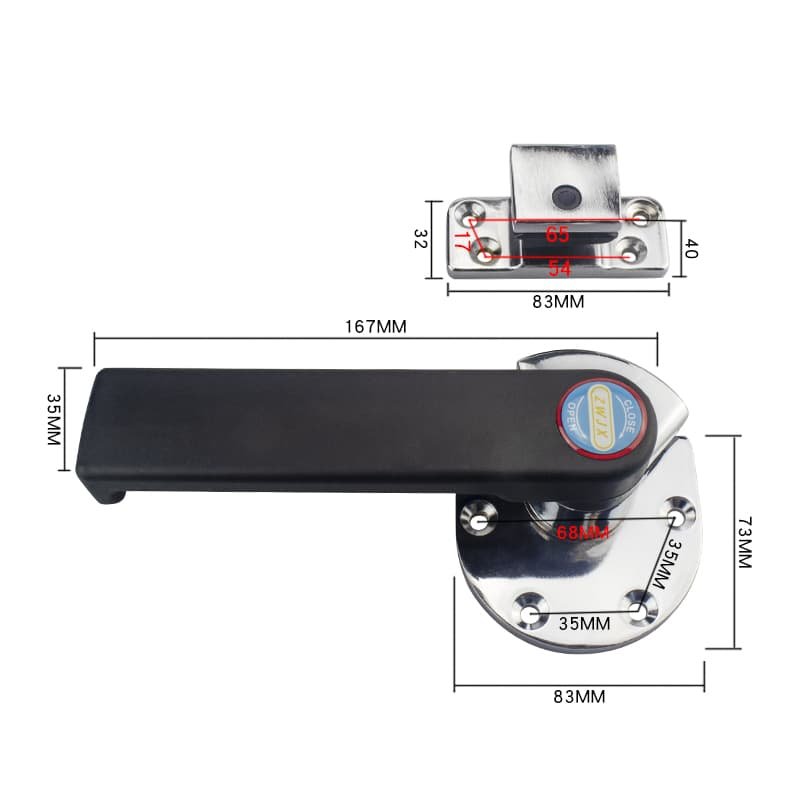
ತಣ್ಣನೆಯ ಕೋಣೆಯ ಬಾಗಿಲಿನ ಬೀಗಗಳ ನಿರ್ವಹಣೆ ಮತ್ತು ಕಾಳಜಿ
ತಣ್ಣನೆಯ ಕೋಣೆಯ ಬಾಗಿಲು ಬೀಗಗಳನ್ನು ಆಗಾಗ್ಗೆ ಬಳಸಲಾಗುತ್ತದೆ ಮತ್ತು ಸೌಲಭ್ಯದ ಸೀಲಿಂಗ್ ಅನ್ನು ನೇರವಾಗಿ ಪರಿಣಾಮ ಬೀರುತ್ತದೆ, ಭದ್ರತೆ, ಮತ್ತು ದಕ್ಷತೆ. ದೀರ್ಘಕಾಲೀನ ಕಾರ್ಯಕ್ಷಮತೆಯನ್ನು ಖಾತರಿಪಡಿಸಿಕೊಳ್ಳಲು ಮತ್ತು ಲಾಕ್ನ ಜೀವಿತಾವಧಿಯನ್ನು ವಿಸ್ತರಿಸಲು ಸರಿಯಾದ ದೈನಂದಿನ ನಿರ್ವಹಣೆ ಮತ್ತು ಆವರ್ತಕ ಆರೈಕೆ ಅವಶ್ಯಕವಾಗಿದೆ.
1. ಕೋಲ್ಡ್ ರೂಮ್ ಲಾಕ್ಗಳೊಂದಿಗೆ ಸಾಮಾನ್ಯ ಸಮಸ್ಯೆಗಳು
1.1 ಹೆಪ್ಪುಗಟ್ಟುವುದು
- ಕಾರಣಗಳು: ಕೋಣೆಯೊಳಗಿನ ಕಡಿಮೆ ತಾಪಮಾನ ಮತ್ತು ಕಳಪೆ ಲಾಕ್ ವಿನ್ಯಾಸ ಅಥವಾ ಸೀಲಿಂಗ್ ಬಾಹ್ಯ ತೇವಾಂಶವನ್ನು ಲಾಕ್ ಸಿಲಿಂಡರ್ ಅನ್ನು ಪ್ರವೇಶಿಸಲು ಮತ್ತು ಫ್ರೀಜ್ ಮಾಡಲು ಅನುವು ಮಾಡಿಕೊಡುತ್ತದೆ.
- ಪರಿಣಾಮ: ಹೆಪ್ಪುಗಟ್ಟಿದ ಬೀಗಗಳು ಕಾರ್ಯನಿರ್ವಹಿಸುವುದು ಕಷ್ಟ, ಸೀಲಿಂಗ್ ಅನ್ನು ರಾಜಿ ಮಾಡುವುದು ಮತ್ತು ಉತ್ಪನ್ನ ನಷ್ಟಕ್ಕೆ ಕಾರಣವಾಗುತ್ತದೆ.
1.2 ತುಕ್ಕು
- ಕಾರಣಗಳು: ಹೆಚ್ಚಿನ ಆರ್ದ್ರತೆ ಅಥವಾ ನಾಶಕಾರಿ ಅನಿಲಗಳು (ಉದಾ., ಆಹಾರ ಸಂಗ್ರಹಣೆಯಲ್ಲಿ ಉಪ್ಪು) ಕ್ರಮೇಣ ಲಾಕ್ ದೇಹ ಮತ್ತು ಸಿಲಿಂಡರ್ ಅನ್ನು ನಾಶಮಾಡಿ.
- ಪರಿಣಾಮ: ಬೀಗಗಳು ಅಸಹ್ಯವಾಗಬಹುದು, ದಮ್ಮ, ಅಥವಾ ಬಾಳಿಕೆ ಕಳೆದುಕೊಳ್ಳಿ.
1.3 ಅಂಟಿಕೊಳ್ಳುವ ಅಥವಾ ಗಟ್ಟಿಯಾದ ಲಾಕ್ ಸಿಲಿಂಡರ್ಗಳು
- ಕಾರಣಗಳು: ಕಡಿಮೆ-ತಾಪಮಾನದ ಪರಿಸರಗಳು ಲೂಬ್ರಿಕಂಟ್ ವೈಫಲ್ಯಕ್ಕೆ ಕಾರಣವಾಗುತ್ತವೆ, ಅಥವಾ ಲಾಕ್ ಸಿಲಿಂಡರ್ಗೆ ಪ್ರವೇಶಿಸುವ ಭಗ್ನಾವಶೇಷಗಳು.
- ಪರಿಣಾಮ: ಹೆಚ್ಚಿದ ಕಾರ್ಯಾಚರಣೆಯ ತೊಂದರೆಗಳು ಮತ್ತು ಹೆಚ್ಚಿನ ವೈಫಲ್ಯ ದರಗಳು.
1.4 ಸೀಲಿಂಗ್ ಕಾರ್ಯಕ್ಷಮತೆ ಕಡಿಮೆಯಾಗಿದೆ
- ಕಾರಣಗಳು: ಲಾಕ್ ಮತ್ತು ಡೋರ್ ಫ್ರೇಮ್ ಅಥವಾ ವಯಸ್ಸಾದ ಮುದ್ರೆಗಳ ನಡುವೆ ತಪ್ಪಾಗಿ ಜೋಡಣೆ.
- ಪರಿಣಾಮ: ಶೀತ ಗಾಳಿ ಸೋರಿಕೆ, ಹೆಚ್ಚಿದ ಶಕ್ತಿಯ ಬಳಕೆ, ಮತ್ತು ಅಸ್ಥಿರ ಆಂತರಿಕ ತಾಪಮಾನ.
2. ಕೋಲ್ಡ್ ರೂಮ್ ಲಾಕ್ಗಳಿಗಾಗಿ ದೈನಂದಿನ ತಪಾಸಣೆ
2.1 ಬಾಹ್ಯ ಪರಿಶೀಲನೆ
- ಗೋಚರ ತುಕ್ಕುಗಾಗಿ ಪರಿಶೀಲಿಸಿ, ಬಿರುಕುಗಳು, ಅಥವಾ ಲಾಕ್ ಮೇಲ್ಮೈಯಲ್ಲಿ ಧರಿಸಿ.
- ಹ್ಯಾಂಡಲ್ಗಳು ಮತ್ತು ಲಾಕ್ ದೇಹಗಳು ಸುರಕ್ಷಿತ ಮತ್ತು ಹಾನಿಗೊಳಗಾಗುವುದಿಲ್ಲ ಎಂದು ಖಚಿತಪಡಿಸಿಕೊಳ್ಳಿ.
2.2 ಲಾಕ್ ಸಿಲಿಂಡರ್ ಚೆಕ್
- ಲಾಕ್ ಕಾರ್ಯವಿಧಾನದ ಸುಗಮ ಕಾರ್ಯಾಚರಣೆಗಾಗಿ ಪರೀಕ್ಷೆ, ಸಿಲಿಂಡರ್ ಅನ್ನು ಖಾತ್ರಿಪಡಿಸುವುದು ಅಂಟಿಕೊಳ್ಳದೆ ತಿರುಗುತ್ತದೆ.
- ಲಾಕ್ ಸಿಲಿಂಡರ್ ಒಳಗೆ ಭಗ್ನಾವಶೇಷಗಳು ಅಥವಾ ಒಣಗಿದ ಲೂಬ್ರಿಕಂಟ್ಗಳಿಗಾಗಿ ಪರೀಕ್ಷಿಸಿ.
2.3 ಸೀಲಿಂಗ್ ಚೆಕ್
- ಲಾಕ್ ತೊಡಗಿಸಿಕೊಂಡಾಗ ಬಾಗಿಲು ಮತ್ತು ಚೌಕಟ್ಟಿನ ನಡುವಿನ ಮುದ್ರೆಯು ಬಿಗಿಯಾಗಿರುತ್ತದೆ ಎಂದು ದೃ irm ೀಕರಿಸಿ.
- ಲಾಕ್ ಸುತ್ತಲೂ ತಂಪಾದ ಗಾಳಿಯ ಸೋರಿಕೆಯನ್ನು ಕಂಡುಹಿಡಿಯಲು ಉಷ್ಣ ಕಾಗದ ಅಥವಾ ಹೊಗೆ ಪರೀಕ್ಷೆಗಳನ್ನು ಬಳಸಿ.
2.4 ಕಾರ್ಯ ಪರೀಕ್ಷೆ
- ಎಲೆಕ್ಟ್ರಾನಿಕ್ ಅಥವಾ ಸ್ಮಾರ್ಟ್ ಲಾಕ್ಗಳಿಗಾಗಿ, ನಿಯಮಿತವಾಗಿ ಬ್ಯಾಟರಿ ಅವಧಿಯನ್ನು ಪರೀಕ್ಷಿಸಿ, ಎಚ್ಚರಿಕೆಯ ವ್ಯವಸ್ಥೆಗಳು, ಮತ್ತು ರಿಮೋಟ್ ಕಂಟ್ರೋಲ್ ಕ್ರಿಯಾತ್ಮಕತೆ.
- ಎಲ್ಲಾ ಅನ್ಲಾಕಿಂಗ್ ವಿಧಾನಗಳನ್ನು ಪರಿಶೀಲಿಸಿ (ಉದಾ., ಕೀಲಿಗಳು, ಪಾಸ್ವರ್ಡ್ಗಳು, ಬೆರಳುಗಳುಳ್ಳ) ಉದ್ದೇಶಿಸಿದಂತೆ ಕೆಲಸ ಮಾಡಿ.
3. ಕೋಲ್ಡ್ ರೂಮ್ ಲಾಕ್ಗಳಿಗಾಗಿ ನಿರ್ವಹಣೆ ವಿಧಾನಗಳು
3.1 ಆಂಟಿ-ಫ್ರೀಜ್ ಕ್ರಮಗಳು
- ಕಡಿಮೆ ತಾಪಮಾನದಲ್ಲಿ ಸುಗಮ ಕಾರ್ಯಾಚರಣೆಯನ್ನು ಖಚಿತಪಡಿಸಿಕೊಳ್ಳಲು ಲಾಕ್ ಸಿಲಿಂಡರ್ಗೆ ಆಂಟಿ-ಫ್ರೀಜ್ ಲೂಬ್ರಿಕಂಟ್ಗಳನ್ನು ಅನ್ವಯಿಸಿ.
- ಘನೀಕರಿಸುವಿಕೆಯನ್ನು ತಡೆಗಟ್ಟಲು ಬೀಗಗಳು ಮತ್ತು ಅವುಗಳ ಸುತ್ತಮುತ್ತಲಿನ ಫ್ರಾಸ್ಟ್ ಮತ್ತು ಐಸ್ ಅನ್ನು ನಿಯಮಿತವಾಗಿ ತೆಗೆದುಹಾಕಿ.
- ಆಂಟಿ-ಫ್ರೀಜ್ ರಚನೆಗಳಿಗೆ ಯಾವುದೇ ಹಾನಿಯನ್ನು ಪರಿಶೀಲಿಸಿ ಮತ್ತು ಸರಿಪಡಿಸಿ, ರಕ್ಷಣಾತ್ಮಕ ಪದರಗಳು ಅಥವಾ ತಾಪನ ಅಂಶಗಳಂತಹ.
3.2 ಆಂಟಿ-ಸೊಂಟನ್ ಆರೈಕೆ
- ಲಾಕ್ ಬಾಡಿ ಮೇಲೆ ಆಂಟಿ-ಹರ್ಸ್ಟ್ ಲೇಪನಗಳನ್ನು ಸಿಂಪಡಿಸಿ, ವಿಶೇಷವಾಗಿ ಸ್ಟೇನ್ಲೆಸ್ ಸ್ಟೀಲ್ ಮಾದರಿಗಳಿಗೆ.
- ನಾಶಕಾರಿ ಅನಿಲಗಳು ಅಥವಾ ದ್ರವಗಳಿಗೆ ದೀರ್ಘಕಾಲದವರೆಗೆ ಒಡ್ಡಿಕೊಳ್ಳುವುದನ್ನು ತಪ್ಪಿಸಿ.
- ಉಪ್ಪು ಅಥವಾ ರಾಸಾಯನಿಕಗಳನ್ನು ನಿರ್ಮಿಸುವುದನ್ನು ತಡೆಯಲು ಲಾಕ್ ದೇಹ ಮತ್ತು ಫ್ರೇಮ್ ಅನ್ನು ನಿಯಮಿತವಾಗಿ ಸ್ವಚ್ Clean ಗೊಳಿಸಿ.
3.3 ಎಲುಬಿನ ನಿರ್ವಹಣೆ
- ಪ್ರತಿ 2-3 ತಿಂಗಳಿಗೊಮ್ಮೆ, ಲಾಕ್ ಸಿಲಿಂಡರ್ ಒಳಗೆ ವಿಶೇಷ ಕಡಿಮೆ-ತಾಪಮಾನದ ಲೂಬ್ರಿಕಂಟ್ಗಳನ್ನು ಅನ್ವಯಿಸಿ.
- ಸ್ಟ್ಯಾಂಡರ್ಡ್ ಲೂಬ್ರಿಕಂಟ್ಗಳನ್ನು ಬಳಸುವುದನ್ನು ತಪ್ಪಿಸಿ, ಇದು ಕಡಿಮೆ ತಾಪಮಾನದಲ್ಲಿ ವಿಫಲವಾಗಬಹುದು ಅಥವಾ ಹೆಪ್ಪುಗಟ್ಟಬಹುದು.
3.4 ಎಲೆಕ್ಟ್ರಾನಿಕ್ ಮತ್ತು ಸ್ಮಾರ್ಟ್ ಲಾಕ್ ಆರೈಕೆ
- ಎಲೆಕ್ಟ್ರಾನಿಕ್ ಲಾಕ್ಗಳ ಬ್ಯಾಟರಿ ಸ್ಥಿತಿಯನ್ನು ನಿಯತಕಾಲಿಕವಾಗಿ ಪರಿಶೀಲಿಸಿ, ಪ್ರತಿ ಬ್ಯಾಟರಿಗಳನ್ನು ಬದಲಾಯಿಸಿ 6 ಅಗತ್ಯವಿದ್ದರೆ ತಿಂಗಳುಗಳು.
- ಬ್ಯಾಕಪ್ ಪರ್ಯಾಯ ಅನ್ಲಾಕಿಂಗ್ ವಿಧಾನಗಳು (ಉದಾ., ಬಿಡಿ ಕೀಗಳು ಅಥವಾ ಪಾಸ್ವರ್ಡ್ಗಳು) ಬೀಗಮುದ್ರೆಗಳನ್ನು ತಪ್ಪಿಸಲು.
- ಅತ್ಯುತ್ತಮ ಕಾರ್ಯಕ್ಷಮತೆಯನ್ನು ಕಾಪಾಡಿಕೊಳ್ಳಲು ಸಂವೇದಕಗಳು ಮತ್ತು ಇಂಟರ್ಫೇಸ್ಗಳನ್ನು ಸ್ವಚ್ clean ವಾಗಿರಿಸಿಕೊಳ್ಳಿ.
3.5 ಕಾರ್ಯಕ್ಷಮತೆ ನಿರ್ವಹಣೆ ಸೀಲಿಂಗ್
- ಅಗತ್ಯವಿರುವಂತೆ ಲಾಕ್ ಬಳಿ ಮುದ್ರೆಗಳನ್ನು ಪರೀಕ್ಷಿಸಿ ಮತ್ತು ಬದಲಾಯಿಸಿ, ವಿಶೇಷವಾಗಿ ಅವರು ಉಡುಗೆ ಅಥವಾ ಹಾನಿಯ ಚಿಹ್ನೆಗಳನ್ನು ತೋರಿಸಿದರೆ.
- ಸೂಕ್ತವಾದ ಸೀಲಿಂಗ್ ಕಾರ್ಯಕ್ಷಮತೆಗಾಗಿ ಲಾಕ್ ಮತ್ತು ಡೋರ್ ಫ್ರೇಮ್ ನಡುವೆ ಸರಿಯಾದ ಜೋಡಣೆಯನ್ನು ಖಚಿತಪಡಿಸಿಕೊಳ್ಳಿ.
4. ವೃತ್ತಿಪರ ನಿರ್ವಹಣೆ ಮತ್ತು ಬದಲಿ
4.1 ನಿಯಮಿತ ವೃತ್ತಿಪರ ತಪಾಸಣೆ
- ಲಾಕ್ ದೇಹವನ್ನು ನಿರ್ಣಯಿಸಲು ಅರ್ಹ ತಂತ್ರಜ್ಞರಿಂದ ವಾರ್ಷಿಕ ತಪಾಸಣೆಯನ್ನು ನಿಗದಿಪಡಿಸಿ, ಸಿಲಿಂಡರ್, ಮತ್ತು ಸೀಲಿಂಗ್ ವ್ಯವಸ್ಥೆ.
- ನವೀಕರಣ ಅಥವಾ ಬದಲಿ ಅಗತ್ಯವಿದೆಯೇ ಎಂದು ನಿರ್ಧರಿಸಲು ಹಳೆಯ ಬೀಗಗಳನ್ನು ಪರೀಕ್ಷಿಸಿ.
4.2 ವಯಸ್ಸಾದ ಘಟಕಗಳನ್ನು ಬದಲಾಯಿಸಿ
- ಹಾನಿಗೊಳಗಾದ ಮುದ್ರೆಗಳನ್ನು ತಕ್ಷಣ ಬದಲಾಯಿಸಿ, ಸಿಲಿಂಡುಗಳು, ಅಥವಾ ಆಂತರಿಕ ಭಾಗಗಳು ಗಮನಾರ್ಹ ಉಡುಗೆಗಳನ್ನು ತೋರಿಸುತ್ತವೆ.
- ಆಗಾಗ್ಗೆ ವೈಫಲ್ಯಗಳು ಅಥವಾ ಕಳಪೆ ಕಾರ್ಯಕ್ಷಮತೆಗೆ ಒಳಗಾಗುವ ಹಳತಾದ ಬೀಗಗಳನ್ನು ಅಪ್ಗ್ರೇಡ್ ಮಾಡುವುದನ್ನು ಪರಿಗಣಿಸಿ.
4.3 ಸ್ಮಾರ್ಟ್ ಲಾಕ್ಗಳಿಗೆ ಅಪ್ಗ್ರೇಡ್ ಮಾಡಿ
- ಸುಧಾರಿತ ಸುರಕ್ಷತೆ ಮತ್ತು ನಿರ್ವಹಣಾ ದಕ್ಷತೆಗಾಗಿ ಸಾಂಪ್ರದಾಯಿಕ ಯಾಂತ್ರಿಕ ಲಾಕ್ಗಳನ್ನು ಎಲೆಕ್ಟ್ರಾನಿಕ್ ಅಥವಾ ಸ್ಮಾರ್ಟ್ ಲಾಕ್ಗಳೊಂದಿಗೆ ಬದಲಾಯಿಸಿ.
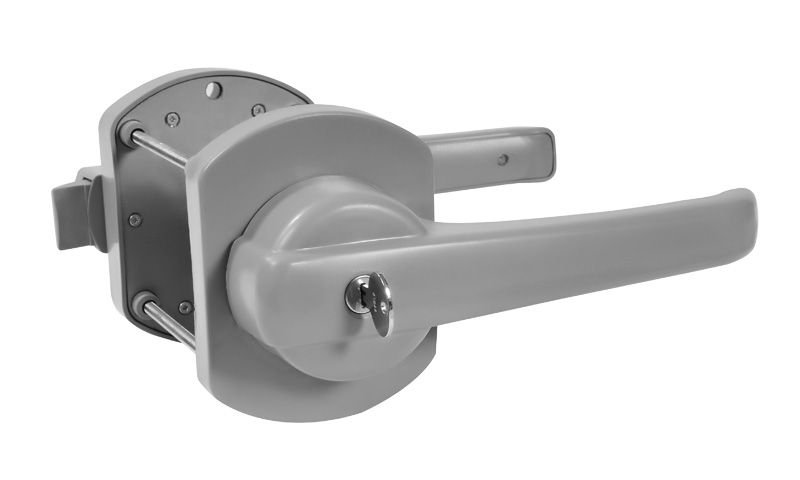
ಕೋಲ್ಡ್ ರೂಮ್ ಡೋರ್ ಲಾಕ್ಗಳಿಗಾಗಿ ಮಾರುಕಟ್ಟೆ ಪ್ರವೃತ್ತಿಗಳು ಮತ್ತು ಆವಿಷ್ಕಾರಗಳು
1. ಮಾರುಕಟ್ಟೆ ಪ್ರವೃತ್ತಿಗಳು
1.1 ಸ್ಮಾರ್ಟ್ ವೈಶಿಷ್ಟ್ಯಗಳ ಬೇಡಿಕೆಯಲ್ಲಿ ಗಮನಾರ್ಹ ಬೆಳವಣಿಗೆ
ಐಒಟಿ ಮತ್ತು ಕೃತಕ ಬುದ್ಧಿಮತ್ತೆಯನ್ನು ವ್ಯಾಪಕವಾಗಿ ಅಳವಡಿಸಿಕೊಳ್ಳುವುದರೊಂದಿಗೆ, ತಣ್ಣನೆಯ ಕೋಣೆ ಬಾಗಿಲಿನ ಬೀಗಗಳು ಸಾಂಪ್ರದಾಯಿಕ ಯಾಂತ್ರಿಕ ವಿನ್ಯಾಸಗಳಿಂದ ಸ್ಮಾರ್ಟ್ ಪರಿಹಾರಗಳಿಗೆ ಪರಿವರ್ತನೆಗೊಳ್ಳುತ್ತಿವೆ.
- ವ್ಯವಹಾರಗಳು ಈಗ ಮೂಲ ಲಾಕಿಂಗ್ ಮತ್ತು ಅನ್ಲಾಕಿಂಗ್ ಕಾರ್ಯಗಳಿಗಿಂತ ಹೆಚ್ಚಿನದನ್ನು ನಿರೀಕ್ಷಿಸುತ್ತವೆ; ಅವರು ರಿಮೋಟ್ ಮಾನಿಟರಿಂಗ್ನಂತಹ ವೈಶಿಷ್ಟ್ಯಗಳನ್ನು ಹುಡುಕುತ್ತಾರೆ, ಪ್ರವೇಶ ರೆಕಾರ್ಡ್ ಟ್ರ್ಯಾಕಿಂಗ್, ಮತ್ತು ಸ್ವಯಂಚಾಲಿತ ಅಲಾರಂಗಳು.
- ಸ್ಮಾರ್ಟ್ ಕೋಲ್ಡ್ ರೂಮ್ ಲಾಕ್ಗಳ ಪ್ರಸರಣವು ನಿರ್ವಹಣಾ ದಕ್ಷತೆಯನ್ನು ಹೆಚ್ಚು ಹೆಚ್ಚಿಸಿದೆ, ಸುರಕ್ಷತೆ, ಮತ್ತು ಕಾರ್ಯಾಚರಣೆಯ ನಿಯಂತ್ರಣ.
1.2 ಪರಿಸರ ಸುಸ್ಥಿರತೆ ಮತ್ತು ಶಕ್ತಿಯ ದಕ್ಷತೆಯ ಮೇಲೆ ಕೇಂದ್ರೀಕರಿಸಿ
ಇಂಧನ ಸಂರಕ್ಷಣೆ ಮತ್ತು ಹೊರಸೂಸುವಿಕೆ ಕಡಿತಕ್ಕಾಗಿ ಜಾಗತಿಕ ತಳ್ಳುವಿಕೆಯ ವಿರುದ್ಧ, ದಿ ತಣ್ಣನೆಯ ಕೋಣೆಯ ಬಾಗಿಲು ಲಾಕ್ ಉದ್ಯಮವು ಪರಿಸರ ಸ್ನೇಹಿ ಪರಿಹಾರಗಳತ್ತ ಸಾಗುತ್ತಿದೆ.
- ಲಾಕ್ ತಯಾರಿಕೆಯಲ್ಲಿ ನವೀಕರಿಸಬಹುದಾದ ಮತ್ತು ಮರುಬಳಕೆ ಮಾಡಬಹುದಾದ ವಸ್ತುಗಳ ಬಳಕೆಗೆ ಕಂಪನಿಗಳು ಆದ್ಯತೆ ನೀಡುತ್ತಿವೆ.
- ಅಧಿಕ-ಸೀಲಿಂಗ್-ಕಾರ್ಯಕ್ಷಮತೆಯ ಲಾಕ್ಗಳಿಗೆ ಹೆಚ್ಚಿನ ಬೇಡಿಕೆ ಇದೆ, ಅದು ಶಕ್ತಿಯ ಬಳಕೆಯನ್ನು ಕಡಿಮೆ ಮಾಡುತ್ತದೆ ಮತ್ತು ಪರಿಸರ ಪರಿಣಾಮ ಮತ್ತು ಕಾರ್ಯಾಚರಣೆಯ ವೆಚ್ಚಗಳನ್ನು ಕಡಿಮೆ ಮಾಡುತ್ತದೆ.
1.3 ಗ್ರಾಹಕೀಕರಣಕ್ಕಾಗಿ ಹೆಚ್ಚುತ್ತಿರುವ ಬೇಡಿಕೆ
ಶೀತಲ ಕೋಣೆಯ ಲಾಕ್ಗಳ ಅವಶ್ಯಕತೆಗಳು ಶೇಖರಣಾ ಪ್ರಕಾರ ಮತ್ತು ಉದ್ಯಮದ ಆಧಾರದ ಮೇಲೆ ಹೆಚ್ಚು ನಿರ್ದಿಷ್ಟವಾಗುತ್ತಿವೆ.
- Ce ಷಧೀಯ ತಣ್ಣನೆಯ ಕೋಣೆ: ನಿಖರ ತಾಪಮಾನ ನಿಯಂತ್ರಣ ಅಲಾರಂಗಳು ಮತ್ತು ಕಟ್ಟುನಿಟ್ಟಾದ ಪ್ರವೇಶ ನಿರ್ವಹಣೆಗೆ ಒತ್ತು.
- ಆಹಾರ ಕೋಲ್ಡ್ ರೂಮ್: ತುಕ್ಕು ನಿರೋಧಕತೆ ಮತ್ತು ಸೀಲಿಂಗ್ ಕಾರ್ಯಕ್ಷಮತೆಯ ಮೇಲೆ ಕೇಂದ್ರೀಕರಿಸಿ.
- ಕೈಗಾರಿಕಾ ಶೀತ ಕೋಣೆ: ಹೆಚ್ಚಿನ ಆವರ್ತನ ಬಳಕೆಯನ್ನು ಬೆಂಬಲಿಸುವ ಬಾಳಿಕೆ ಬರುವ ಮತ್ತು ಬಳಕೆದಾರ ಸ್ನೇಹಿ ಲಾಕ್ಗಳ ಅವಶ್ಯಕತೆ.
2. ತಾಂತ್ರಿಕ ಆವಿಷ್ಕಾರಗಳು
2.1 ಸ್ಮಾರ್ಟ್ ಲಾಕ್ ತಂತ್ರಜ್ಞಾನ
ಸ್ಮಾರ್ಟ್ ಕೋಲ್ಡ್ ರೂಮ್ ಲಾಕ್ಗಳು ತಾಂತ್ರಿಕ ಪ್ರಗತಿಯಲ್ಲಿ ಮುಂಚೂಣಿಯಲ್ಲಿವೆ.
- ಬಯೋಮೆಟ್ರಿಕ್ ಗುರುತಿಸುವಿಕೆ: ಫಿಂಗರ್ಪ್ರಿಂಟ್ ಮತ್ತು ಮುಖ ಗುರುತಿಸುವಿಕೆಯಂತಹ ವೈಶಿಷ್ಟ್ಯಗಳು ಸುರಕ್ಷತೆ ಮತ್ತು ಅನುಕೂಲತೆಯನ್ನು ಹೆಚ್ಚಿಸುತ್ತವೆ.
- ರಿಮೋಟ್ ಕಂಟ್ರೋಲ್ ಮತ್ತು ಐಒಟಿ ಸಂಪರ್ಕ: ಮೊಬೈಲ್ ಅಪ್ಲಿಕೇಶನ್ಗಳು ಅಥವಾ ಕಂಪ್ಯೂಟರ್ಗಳ ಮೂಲಕ ನೈಜ-ಸಮಯದ ಮೇಲ್ವಿಚಾರಣೆ ಮತ್ತು ಲಾಕ್ ಸ್ಥಿತಿಯ ನಿಯಂತ್ರಣ, ರಿಮೋಟ್ ಅನ್ಲಾಕಿಂಗ್ ಅನ್ನು ಬೆಂಬಲಿಸಲಾಗುತ್ತಿದೆ, ಲಾಕಿಂಗ್, ಮತ್ತು ಎಚ್ಚರಿಕೆ ಕಾರ್ಯಗಳು.
- ಡೇಟಾ ಲಾಗಿಂಗ್ ಮತ್ತು ವಿಶ್ಲೇಷಣೆ: ಸ್ಮಾರ್ಟ್ ಲಾಕ್ಗಳು ಅನ್ಲಾಕಿಂಗ್ ಈವೆಂಟ್ಗಳ ಬಗ್ಗೆ ಮಾಹಿತಿಯನ್ನು ಸಂಗ್ರಹಿಸಬಹುದು, ಸಮಯ ಸೇರಿದಂತೆ, ವಿಧಾನ, ಮತ್ತು ಬಳಕೆದಾರರ ವಿವರಗಳು, ನಿರ್ವಹಣಾ ಪ್ರಕ್ರಿಯೆಗಳನ್ನು ಉತ್ತಮಗೊಳಿಸಲು ಪತ್ತೆಹಚ್ಚಬಹುದಾದ ಡೇಟಾವನ್ನು ಒದಗಿಸುವುದು.
2.2 ವಸ್ತುಗಳು ಮತ್ತು ರಚನಾತ್ಮಕ ವರ್ಧನೆಗಳು
- ಹೊಸ ಮಿಶ್ರಲೋಹಗಳು ಮತ್ತು ಸಂಯೋಜಿತ ವಸ್ತುಗಳು: ತುಕ್ಕು ನಿರೋಧಕತೆ ಮತ್ತು ಕಡಿಮೆ-ತಾಪಮಾನ ಬಾಳಿಕೆ ಸುಧಾರಿಸಲು ಹಗುರವಾದ ಮತ್ತು ಬಲವಾದ ವಸ್ತುಗಳನ್ನು ಪರಿಚಯಿಸಲಾಗುತ್ತಿದೆ.
- ಆಂಟಿ-ಫ್ರೀಜಿಂಗ್ ವಿನ್ಯಾಸ: ನವೀನ ರಚನೆಗಳು ಮತ್ತು ಆಂಟಿ-ಫ್ರೀಜ್ ಲೂಬ್ರಿಕಂಟ್ ತಂತ್ರಜ್ಞಾನಗಳು ತೀವ್ರ ಶೀತದಲ್ಲಿ ಬೀಗಗಳು ಸರಾಗವಾಗಿ ಕಾರ್ಯನಿರ್ವಹಿಸುತ್ತವೆ ಎಂದು ಖಚಿತಪಡಿಸುತ್ತದೆ.
- ಸಮರ್ಥ ಸೀಲಿಂಗ್ ವಿನ್ಯಾಸಗಳು: ಬಹು-ಪದರದ ಮುದ್ರೆಗಳು ಮತ್ತು ಸುಧಾರಿತ ಲಾಕ್ ಬಾಡಿ ವಿನ್ಯಾಸಗಳು ಗಾಳಿಯಾಡುವಿಕೆ ಮತ್ತು ಶಕ್ತಿಯ ದಕ್ಷತೆಯನ್ನು ಹೆಚ್ಚಿಸುತ್ತದೆ.
2.3 ಬುದ್ಧಿವಂತ ಇಂಧನ ಉಳಿತಾಯ ವ್ಯವಸ್ಥೆಗಳು
- ತಾಪಮಾನ ಮತ್ತು ಆರ್ದ್ರತೆ ಸಂವೇದಕಗಳೊಂದಿಗೆ ಸಂಯೋಜಿಸಲ್ಪಟ್ಟ ಸ್ಮಾರ್ಟ್ ಲಾಕ್ಗಳು ಆಂತರಿಕ ಪರಿಸರದ ಆಧಾರದ ಮೇಲೆ ಲಾಕಿಂಗ್ ಕಾರ್ಯವಿಧಾನಗಳನ್ನು ಸ್ವಯಂಚಾಲಿತವಾಗಿ ಹೊಂದಿಸಬಹುದು ತಣ್ಣನೆಯ ಕೋಣೆ.
- ಅಪೂರ್ಣ ಬಾಗಿಲು ಮುಚ್ಚುವಿಕೆಯಿಂದ ತಂಪಾದ ಗಾಳಿಯ ಸೋರಿಕೆಯನ್ನು ತಡೆಯಿರಿ, ಶಕ್ತಿಯ ಬಳಕೆಯನ್ನು ಕಡಿಮೆ ಮಾಡುವುದು.
- ತಾಪಮಾನ ಅಸಂಗತತೆಯ ಅಲಾರಮ್ಗಳನ್ನು ಸಕ್ರಿಯಗೊಳಿಸಿ, ಸಂಗ್ರಹಿಸಿದ ಸರಕುಗಳ ಸುರಕ್ಷತೆಯನ್ನು ಖಚಿತಪಡಿಸಿಕೊಳ್ಳಲು ನೈಜ-ಸಮಯದ ಪ್ರತಿಕ್ರಿಯೆಯನ್ನು ಒದಗಿಸುವುದು.
3. ಭವಿಷ್ಯದ ಅಭಿವೃದ್ಧಿ ನಿರ್ದೇಶನಗಳು
3.1 ಅಡ್ಡ-ಉದ್ಯಮದ ಏಕೀಕರಣ
ತಾಂತ್ರಿಕ ಪ್ರಗತಿಯೊಂದಿಗೆ, ಕೋಲ್ಡ್ ರೂಮ್ ಲಾಕ್ಗಳು ಇತರ ಕೈಗಾರಿಕೆಗಳ ಪರಿಹಾರಗಳೊಂದಿಗೆ ಹೆಚ್ಚು ಸಂಯೋಜನೆಗೊಳ್ಳುತ್ತವೆ.
- ಭದ್ರತಾ ತಂತ್ರಜ್ಞಾನ: ಡೇಟಾ ಮತ್ತು ಪ್ರವೇಶ ರಕ್ಷಣೆಗಾಗಿ ಡೈನಾಮಿಕ್ ಎನ್ಕ್ರಿಪ್ಶನ್ ಕ್ರಮಾವಳಿಗಳ ಮೂಲಕ ವರ್ಧಿತ ಸುರಕ್ಷತೆ.
- ಸ್ಮಾರ್ಟ್ ಕಟ್ಟಡ ತಂತ್ರಜ್ಞಾನ: ಸಂಯೋಜಿಸುವ ಏಕೀಕೃತ ನಿರ್ವಹಣಾ ಪರಿಹಾರಗಳು ತಣ್ಣನೆಯ ಕೋಣೆ ಮತ್ತು ಕಟ್ಟಡ ವ್ಯವಸ್ಥೆಗಳು.
3.2 ಜೀವನಚಕ್ರ ವಿನ್ಯಾಸ
ಭವಿಷ್ಯದ ವಿನ್ಯಾಸಗಳು ತಮ್ಮ ಸಂಪೂರ್ಣ ಜೀವನಚಕ್ರದಲ್ಲಿ ಕೋಲ್ಡ್ ರೂಮ್ ಲಾಕ್ಗಳ ಮೌಲ್ಯವನ್ನು ಒತ್ತಿಹೇಳುತ್ತವೆ.
- ಉತ್ಪಾದನೆಯಿಂದ ವಿಲೇವಾರಿಗೆ ಪರಿಸರ ಪರಿಣಾಮವನ್ನು ಕಡಿಮೆ ಮಾಡಿ.
- ಜೀವಿತಾವಧಿಯನ್ನು ವಿಸ್ತರಿಸಲು ಮತ್ತು ನಿರ್ವಹಣಾ ವೆಚ್ಚವನ್ನು ಕಡಿಮೆ ಮಾಡಲು ಬಾಳಿಕೆ ಮತ್ತು ನಿರ್ವಹಣೆಯನ್ನು ಉತ್ತಮಗೊಳಿಸಿ.

3.3 ಗ್ರಾಹಕೀಕರಣ ಮತ್ತು ಮಾಡ್ಯುಲರ್ ವಿನ್ಯಾಸ
ಮಾಡ್ಯುಲರ್ ವಿನ್ಯಾಸವು ಪ್ರಮುಖ ಪ್ರವೃತ್ತಿಯಾಗುವ ನಿರೀಕ್ಷೆಯಿದೆ.
- ವ್ಯವಹಾರಗಳು ನಿರ್ದಿಷ್ಟ ಕ್ರಿಯಾತ್ಮಕ ಮಾಡ್ಯೂಲ್ಗಳನ್ನು ಆಯ್ಕೆ ಮಾಡಬಹುದು (ಉದಾ., ಬಯೋಮೆಟ್ರಿಕ್ ಗುರುತಿಸುವಿಕೆ, ದೂರಸ್ಥ ನಿಯಂತ್ರಣ) ವೆಚ್ಚವನ್ನು ಕಡಿಮೆ ಮಾಡುವಾಗ ಅವರ ಅಗತ್ಯಗಳನ್ನು ಪೂರೈಸಲು.
- ಮಾಡ್ಯುಲರ್ ಸಿಸ್ಟಮ್ಸ್ ಭವಿಷ್ಯದ ನವೀಕರಣಗಳು ಮತ್ತು ಘಟಕ ಬದಲಿಗಳನ್ನು ಸರಳಗೊಳಿಸುತ್ತದೆ.
3.4 ಜಾಗತಿಕ ಪ್ರಮಾಣೀಕರಣ
ಕೋಲ್ಡ್ ಚೈನ್ ಲಾಜಿಸ್ಟಿಕ್ಸ್ ಹೆಚ್ಚು ಅಂತರರಾಷ್ಟ್ರೀಯವಾಗುತ್ತಿದ್ದಂತೆ, ಕೋಲ್ಡ್ ರೂಮ್ ಲಾಕ್ ಉದ್ಯಮವು ಪ್ರಮಾಣೀಕರಣದತ್ತ ಸಾಗುತ್ತದೆ.
- ಅಂತರರಾಷ್ಟ್ರೀಯ ಸುರಕ್ಷತೆ ಮತ್ತು ಪರಿಸರ ಮಾನದಂಡಗಳನ್ನು ಪೂರೈಸುವ ಬೀಗಗಳು ಪ್ರಾಬಲ್ಯ ಸಾಧಿಸುತ್ತವೆ, ವಿವಿಧ ಪ್ರದೇಶಗಳಲ್ಲಿನ ನಿಯಮಗಳನ್ನು ಅನುಸರಿಸುವುದು.
- ಪ್ರಮಾಣೀಕೃತ ವಿನ್ಯಾಸಗಳು ಬಹುರಾಷ್ಟ್ರೀಯ ಕಂಪನಿಗಳಿಗೆ ಸಂಗ್ರಹಣೆ ಮತ್ತು ನಿರ್ವಹಣೆಯನ್ನು ಸುಗಮಗೊಳಿಸುತ್ತದೆ, ಚಾಲನಾ ಮಾರುಕಟ್ಟೆ ಸ್ಕೇಲೆಬಿಲಿಟಿ.
ತೀರ್ಮಾನ
ಕೋಲ್ಡ್ ರೂಮ್ ವ್ಯವಸ್ಥೆಗಳ ಅನಿವಾರ್ಯ ಅಂಶವಾಗಿ, ಕೋಲ್ಡ್ ರೂಮ್ ಡೋರ್ ಲಾಕ್ಗಳ ಕಾರ್ಯಕ್ಷಮತೆ ನೇರವಾಗಿ ಸೀಲಿಂಗ್ ಮೇಲೆ ಪರಿಣಾಮ ಬೀರುತ್ತದೆ, ಭದ್ರತೆ, ಮತ್ತು ಸೌಲಭ್ಯದ ಕಾರ್ಯಾಚರಣೆಯ ದಕ್ಷತೆ. ಕೋಲ್ಡ್ ಚೈನ್ ಲಾಜಿಸ್ಟಿಕ್ಸ್ನಂತಹ ಕೈಗಾರಿಕೆಗಳ ತ್ವರಿತ ಅಭಿವೃದ್ಧಿಯೊಂದಿಗೆ, ಆಹಾರ ಸಂಸ್ಕರಣೆ, ಮತ್ತು ce ಷಧೀಯ ಸಂಗ್ರಹಣೆ, ಕೋಲ್ಡ್ ರೂಮ್ ಡೋರ್ ಲಾಕ್ಗಳ ತಾಂತ್ರಿಕ ಆವಿಷ್ಕಾರಗಳು ಮತ್ತು ಅಪ್ಲಿಕೇಶನ್ ಸನ್ನಿವೇಶಗಳು ವಿಕಸನಗೊಳ್ಳುತ್ತಲೇ ಇರುತ್ತವೆ. ಮೂಲ ಕ್ರಿಯಾತ್ಮಕತೆಯಿಂದ ಬುದ್ಧಿವಂತ ನವೀಕರಣಗಳವರೆಗೆ, ವಸ್ತು ಆಯ್ಕೆಯಿಂದ ನಿರ್ವಹಣೆಗೆ, ಪ್ರತಿಯೊಂದು ಅಂಶ ತಣ್ಣನೆಯ ಕೋಣೆಯ ಬಾಗಿಲು ಲಾಕ್ಸ್ ಉದ್ಯಮವನ್ನು ಹೆಚ್ಚಿನ ದಕ್ಷತೆಯತ್ತ ಓಡಿಸುತ್ತಿದೆ, ಸುರಕ್ಷತೆ, ಮತ್ತು ಸಮರ್ಥನೀಯತೆ.
ಭವಿಷ್ಯದಲ್ಲಿ, ಸ್ಮಾರ್ಟ್ ತಂತ್ರಜ್ಞಾನಗಳು ಮತ್ತು ಐಒಟಿ ಏಕೀಕರಣವು ಗಾ en ವಾಗುತ್ತದೆ, ಕೋಲ್ಡ್ ರೂಮ್ ಡೋರ್ ಲಾಕ್ಗಳು ಇನ್ನು ಮುಂದೆ ಸರಳ ಯಾಂತ್ರಿಕ ಸಾಧನಗಳಾಗಿ ಉಳಿಯುವುದಿಲ್ಲ. ಬದಲಾಗಿ, ಅವರು ಕೋಲ್ಡ್ ಚೈನ್ ಮ್ಯಾನೇಜ್ಮೆಂಟ್ನಲ್ಲಿ ನಿರ್ಣಾಯಕ ದತ್ತಾಂಶ ಪ್ರವೇಶ ಬಿಂದುಗಳು ಮತ್ತು ನಿಯಂತ್ರಣ ನೋಡ್ಗಳಾಗಿ ಪರಿಣಮಿಸುತ್ತಾರೆ. ಕೋಲ್ಡ್ ರೂಮ್ ಸರಕುಗಳ ಶೇಖರಣಾ ಗುಣಮಟ್ಟವನ್ನು ಖಾತರಿಪಡಿಸುವುದನ್ನು ಮೀರಿ, ಅವರು ಹೊಸ ಮೌಲ್ಯ ಮತ್ತು ಉದ್ಯಮದ ಸಾಧ್ಯತೆಗಳನ್ನು ಅನ್ಲಾಕ್ ಮಾಡುತ್ತಾರೆ.
ತಯಾರಕರು ಮತ್ತು ಬಳಕೆದಾರರು ಇಬ್ಬರೂ ಆಯ್ಕೆಗೆ ಆದ್ಯತೆ ನೀಡಬೇಕು, ಬಳಸಿ, ಮತ್ತು ನಿರ್ವಹಣೆ ತಣ್ಣನೆಯ ಕೋಣೆಯ ಬಾಗಿಲು ಅವುಗಳ ಕ್ರಿಯಾತ್ಮಕತೆಯನ್ನು ಸಂಪೂರ್ಣವಾಗಿ ಅರಿತುಕೊಳ್ಳಲು ಮತ್ತು ಕೋಲ್ಡ್ ಚೈನ್ ಉದ್ಯಮದ ಉತ್ತಮ-ಗುಣಮಟ್ಟದ ಅಭಿವೃದ್ಧಿಯನ್ನು ಖಚಿತಪಡಿಸಿಕೊಳ್ಳಲು ಲಾಕ್ಗಳು.
ಯಾವುದೇ ಕಾಮೆಂಟ್ಗಳು?
ಸ್ವಾಗತ ಸಂದೇಶವನ್ನು ಕಳುಹಿಸಿ ಅಥವಾ ಮರು ಪೋಸ್ಟ್ ಮಾಡಿ.



